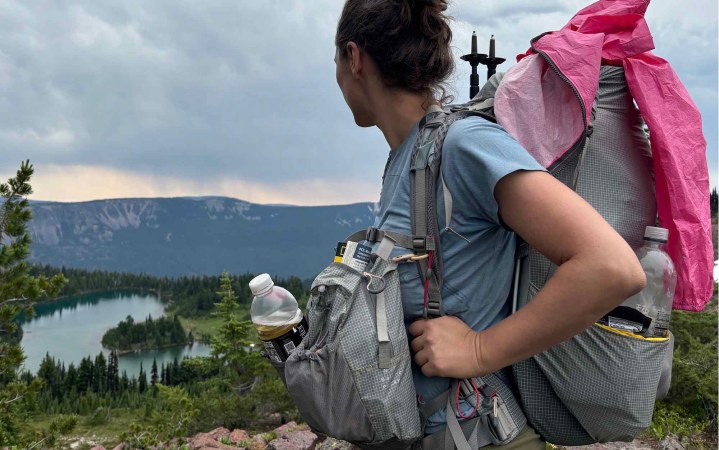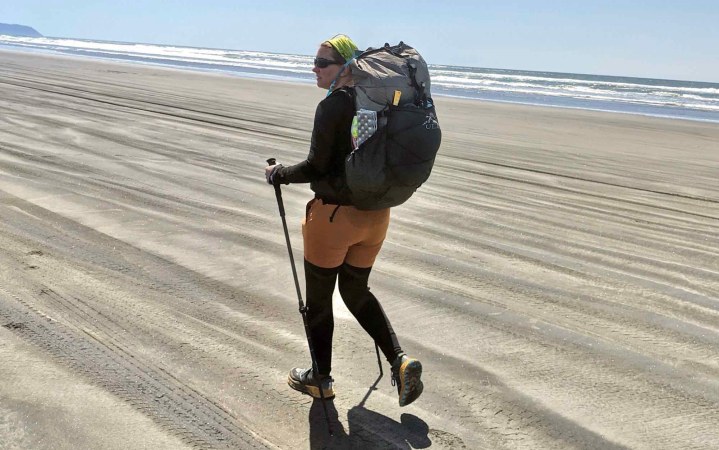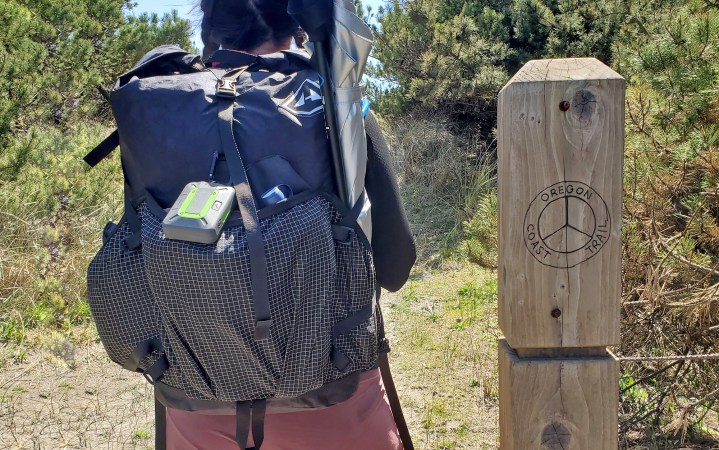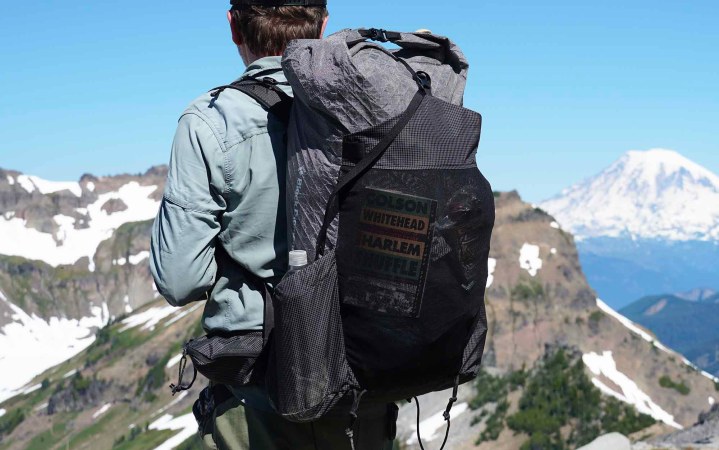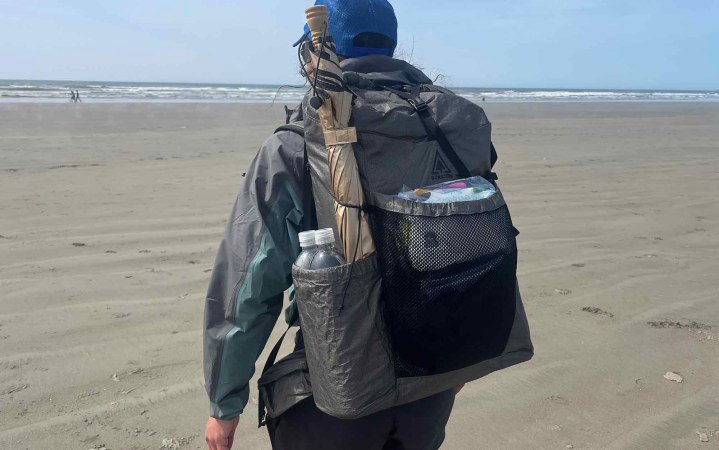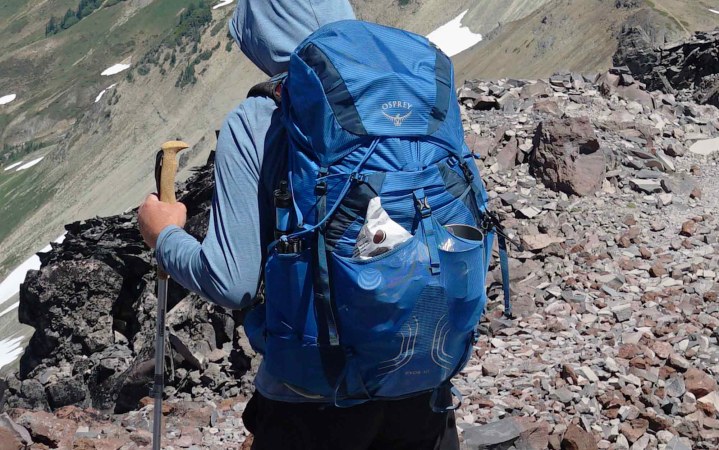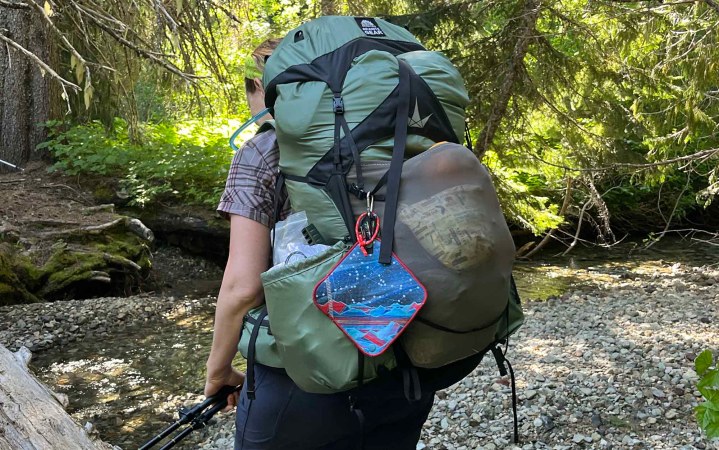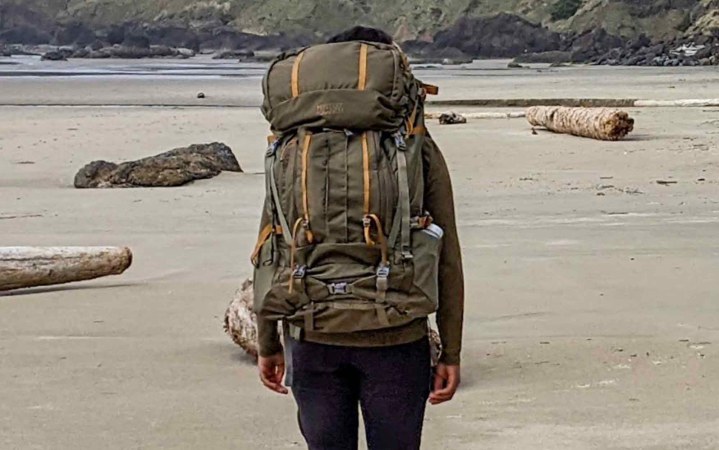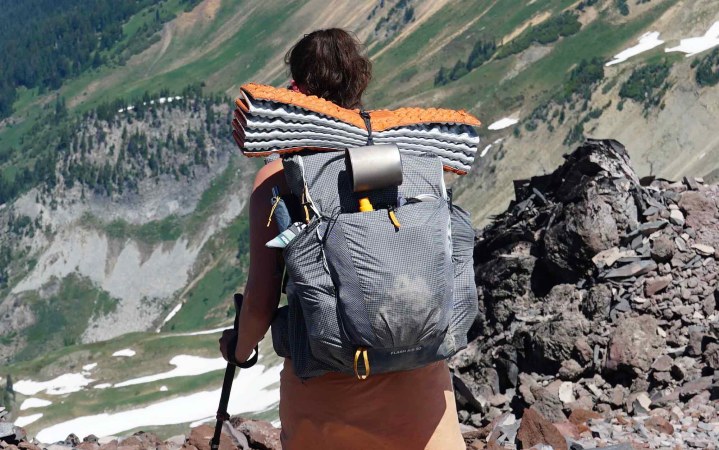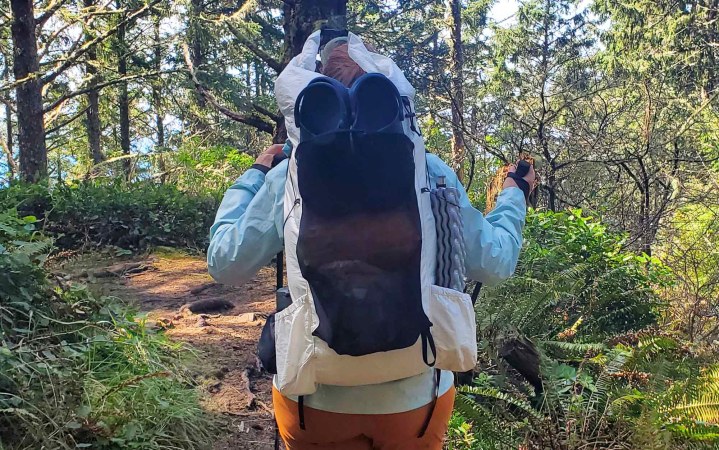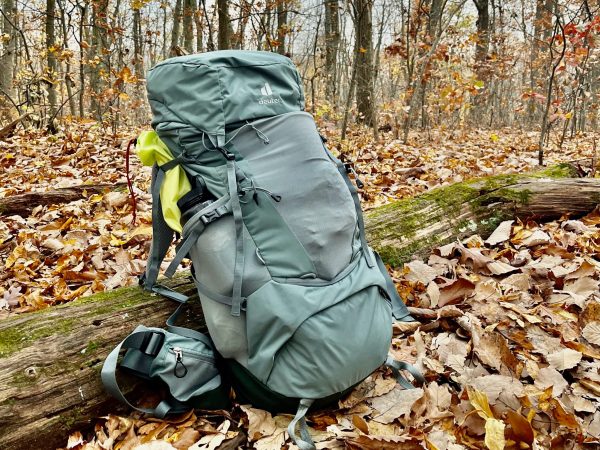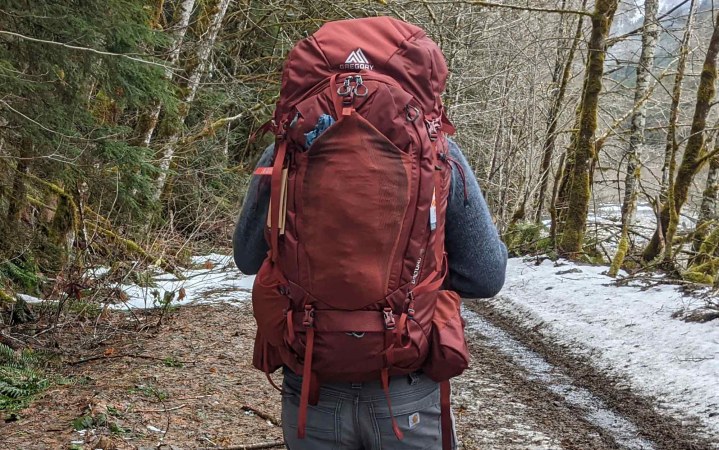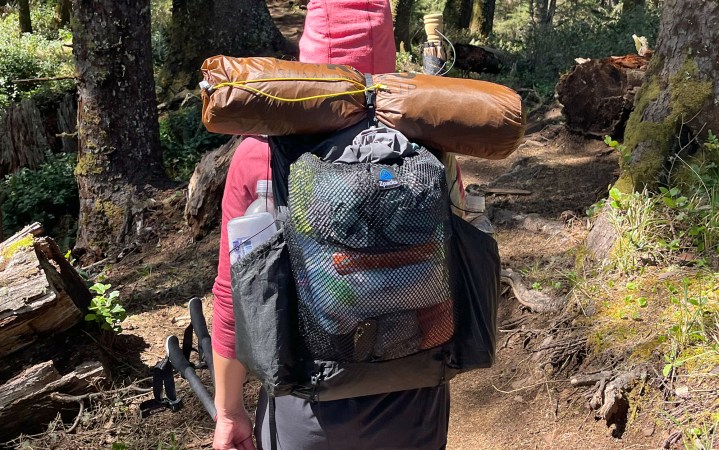The Best Backpacking Backpacks, Tested and Reviewed
We may earn revenue from the products available on this page and participate in affiliate programs. Learn More ›
Backpacking backpacks are undergoing a sea change. Huge 70-liter, heavily padded, fully-featured models are on their way out, and the minimalist packs pioneered by thru-hikers are in. Today’s backpackers can choose from lightweight, streamlined models with a range of frame styles that allow you to position your pack’s weight where it’s most comfortable. To find the best backpacking backpacks for everyone from ultralight diehards to weekend warriors, we conducted side-by-side testing on some of America’s most iconic long trails with a seasoned and diverse group of outdoors people.
Below I’ve organized our top picks into three different frame styles.
- Rigid frame backpacks transfer the majority of a pack’s weight to your hips.
- Wrap-around frame backpacks hug and contour to the body, balancing weight across your torso.
- Removable frame backpacks allow you to choose between these two styles. It does not do either as well as a pack designed for that particular frame style, but allows for versatility.
Frameless backpacks are only appropriate for individuals whose kit is already ultralight, and are covered in our take on the best ultralight backpacks.
↓ Jump to the Best Backpacking Backpacks: Wrap-Around Frames
- Best Overall: Aarn Mountain Magic 50
- Six Moon Designs Swift X
↓ Jump to the Best Backpacking Backpacks: Removable Frames
- Best Overall: ULA Circuit
- Best Load Bearing: Hyperlite Southwest 40
- Black Diamond Beta Light 45
- Durston Kakwa 40
↓ Jump to the Best Backpacking Backpacks: Rigid Frames
- Best Overall: Osprey Exos 48
- Best for Beginners: Granite Gear Crown3
- Best Traditional: Mystery Ranch Bridger
- Mystery Ranch Radix 47
- REI Flash Air 50
- Outdoor Vitals CS40 Ultra
- Deuter AirContact Core 65+10
- Gregory Baltoro & Deva
- Zpacks Ultra Arc Haul
How We Tested the Best Backpacking Backpacks
Selection
We’re living through a golden era of backpacking backpacks: Big brand names like Mystery Ranch, Gregory, and Osprey are fine-tuning their internal frame designs. Mature cottage companies Six Moon Designs, Gossamer Gear, and Granite Gear are finally starting to go mainstream. Meanwhile, hardcore ultralight brands — Zpacks and Hyperlite, I’m looking at you — keep everyone honest. And there are new backpacking backpack brands all the time: Nashville, Symbiosis, and Lite AF.
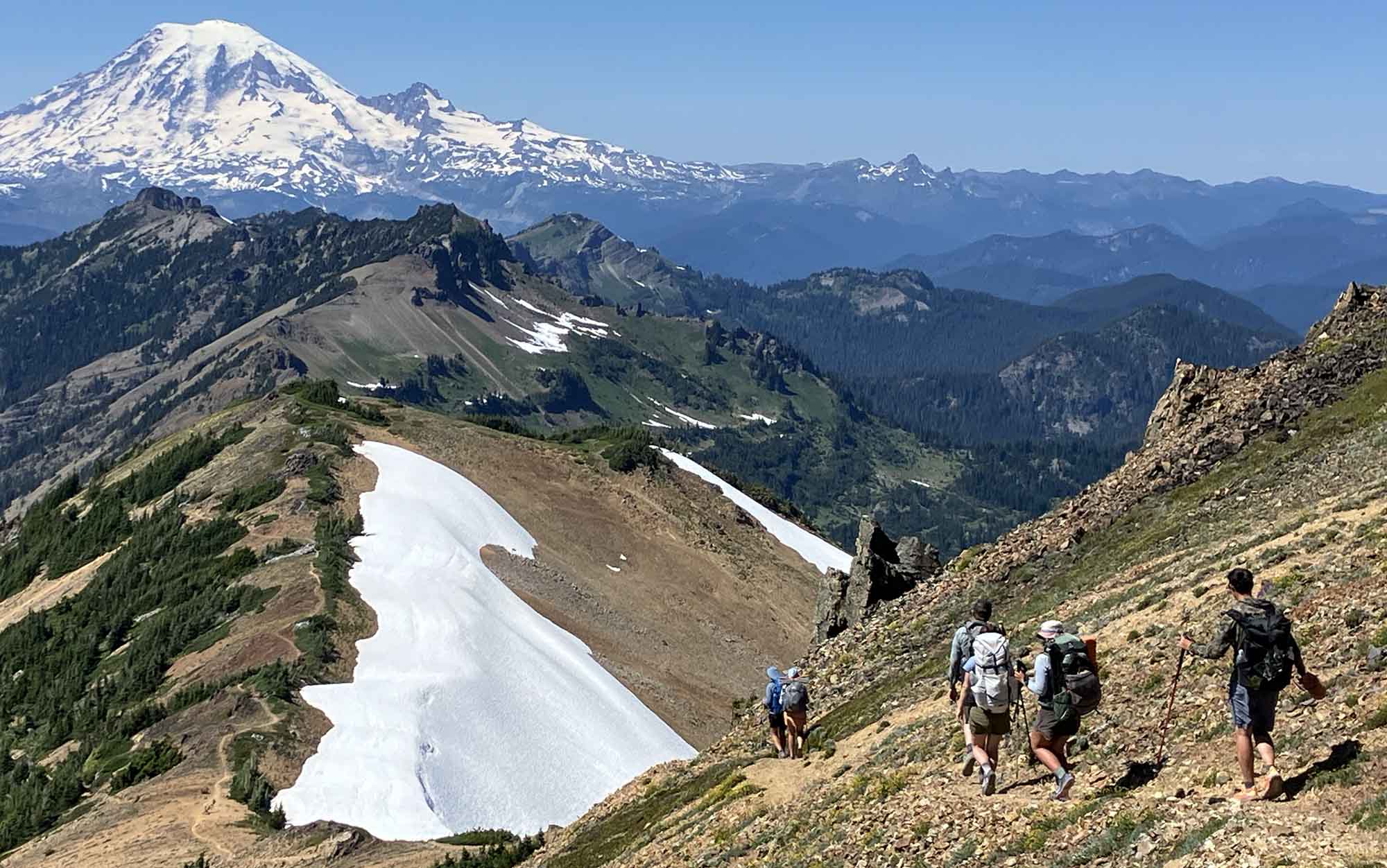
Diana Helmut
While this review does include traditional-style backpacks, the focus is on lightweight and ultralight-style backpacks. There was a time when this style of gear was only appropriate for experienced backpackers, but increasingly brands are experimenting with — and succeeding in — creating lightweight backpacking backpacks that are just as comfortable, capable, and affordable as the six-pound models of yore.
The Testers
To test the best backpacking backpacks, OL recruited a testing panel with a range of experience levels, body types, and preferences.
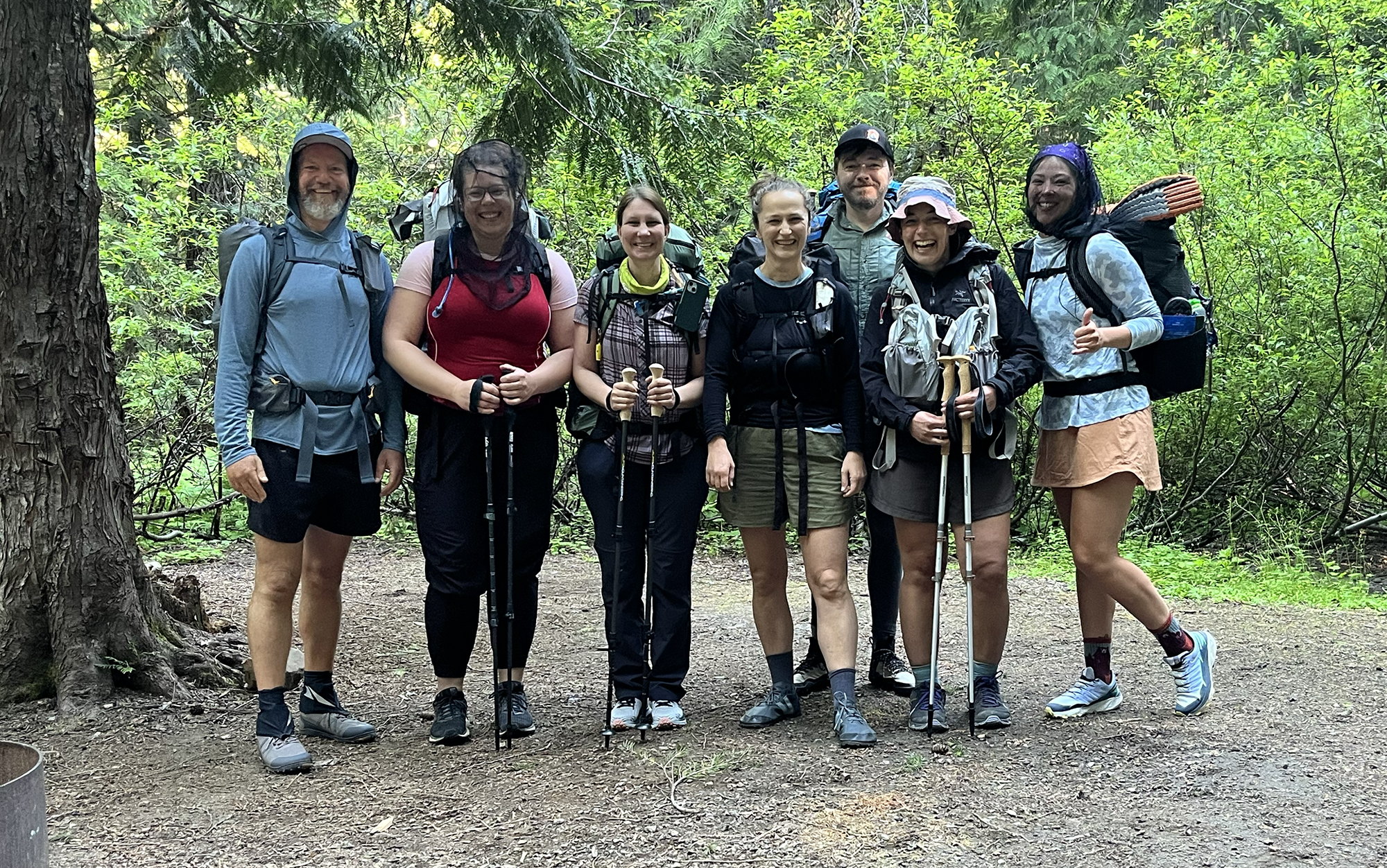
Ashley Thess
- Adam Tycaster: Over 4,000 miles of backpacking experience, including the PCT 2014 and CT 2017. Previous go-to backpacks include the Osprey Exos.
- Alex Robinson: OL editor-in-chief; a backcountry big game hunter and fair-weather trail runner. Previous go-to backpacks include the Stone Glacier Evo 3300 and Kuiu Pro 6000.
- Ashley Thess: Outdoor Life associate gear editor. Over 600 miles of backpacking experience. Previous go-to backpacks include the ULA Ohm.
- Diana Helmuth: Author of How to Suffer Outside (National Outdoor Book Award winner). Over 1,500 miles of backpacking experience. Previous go-to backpacks include the Dana Designs ArcFlex Terraplane.
- Jac “Top Shelf” Mitchel: Over 11,000 miles of backpacking experience including the PCT 2014, CDT 2016, AZT, 2017, and GET 2017. Previous go-to backpacks include the Six Moon Minimalist, Mountain Laurel Designs Burn, and Gossamer G4.
- Jason Boyle: Shenandoah National Park hiking and backpacking guide. Previous go-to backpacks include Six Moon Designs.
- Laura “Chop Chop” Lancaster: OL staff writer. Over 4,000 miles of backpacking experience, including the PCT 2014 and CT 2017. Previous go-to backpacks include the ULA Catalyst and Osprey Talon.
- Patrice “Steady” La Vigne: Gear reviewer, Denali guide, and author of Between Each Step. Over 7,000 miles of backpacking experience, including the AT 2011 and Te Araroa 2014-2015. Previous go-to backpacks include the Gregory Deva and Osprey Aura.
- Rebecca Ross: Outdoor photographer and gear reviewer. Previous go-to backpacks include Gregory, Osprey, and Teton Sports.
- Sven “Magic” Anderson: 1,350-mile LASH (PCT) 2022. Hiking with Parkinson’s disease.
Testing
Outdoor Life conducts an annual backpacking gear testing trip that focuses on innovative lightweight and ultralight backpacking gear. These testing trips take place on America’s national scenic trails, including a 30-mile stretch of the northernmost section of the Oregon Coast Trail and a 40-mile stretch along the Pacific Crest Trail in the Goat Rocks Wilderness.
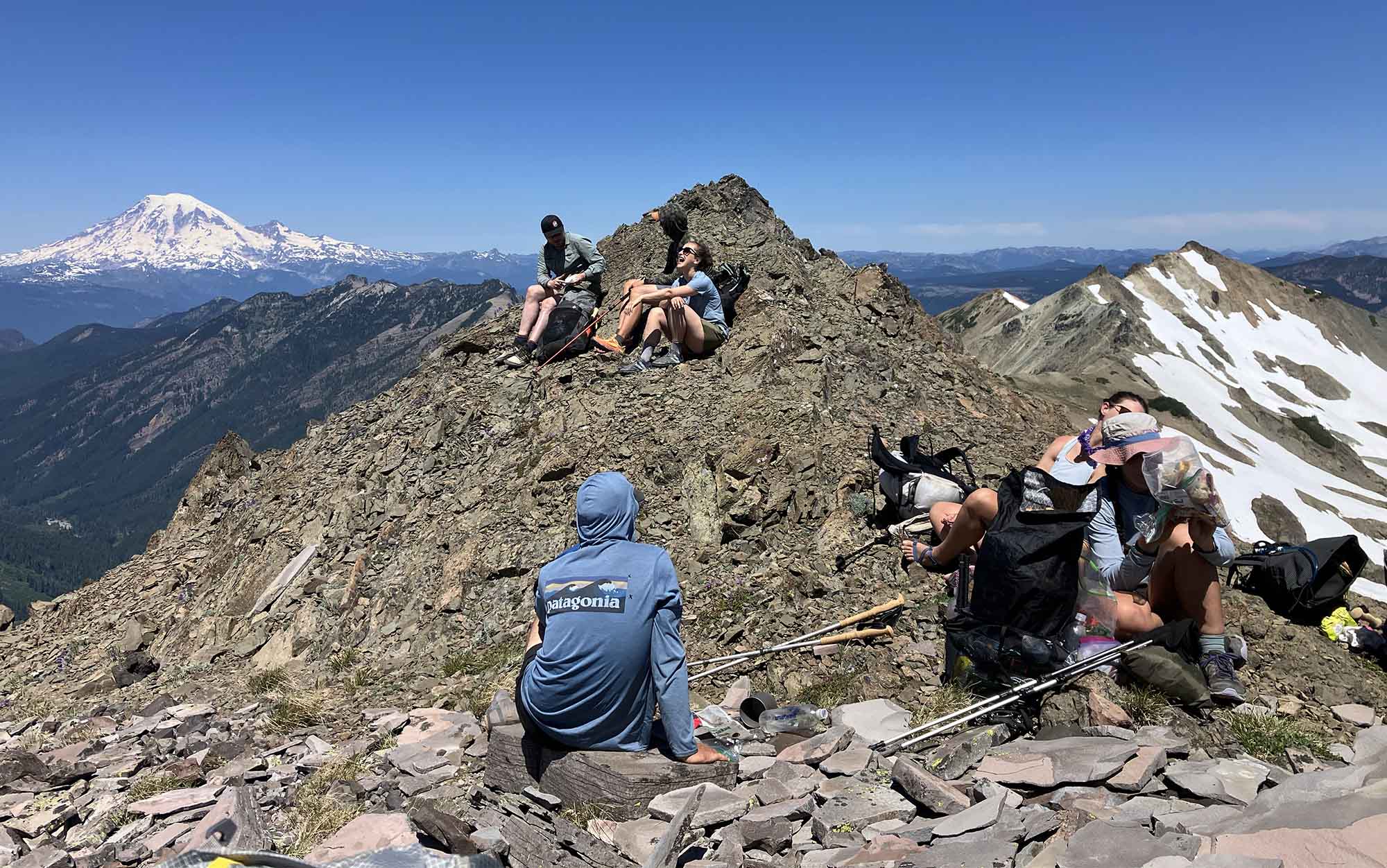
Diana Helmuth
These trips usually see the testing group covering 10 or more miles each day. With our day’s mileage complete we take notes on each pack, as well as the other gear that’s being tested, and then swap out for a different model for the following day. This part can get a little intense as everyone unloads and then reloads all of their gear into a new backpack: think a typical pack explosion, but on steroids and your entire trail family. Over time, each pack’s features, flaws, and even personality began to make themselves known — Top Shelf began to see each pack as one of her children.
Traditional backpacking backpacks are tested individually by Rebecca Ross, Jason Boyle, and Diana Helmuth.
Scoring
After taking copious notes in the field, the testing team then spends a day filling out scoring sheets for each item in the test. We also discuss and compare with one another, which is helpful for understanding how and why experiences with the same gear can vary from person to person.
Backpacking backpacks are scored on fit, comfort, load bearing, packability, accessibility, and value. Scores are then averaged among the testers, with the top scoring packs receiving top honors.
- Fit: Were the testers able to adjust the pack to fit their bodies?
- Comfort: Did the ultralight backpack produce any hot spots or soreness while hiking? Did they look forward to taking it off or did they leave the backpack on during breaks?
- Load Bearing: We measured how heavy our backpacks were each day before heading out to see how well they handled our typical loads, which ran between 15 and 30 pounds.
- Packability: We looked at whether we could fit our typical gear kit into each backpack and how easy (or difficult) it was to balance the load.
- Accessibility: How easily could we get at our gear during the day?
- Value: Was the pack worth the price tag for the features it provides?
Comparison Table
Below is a side-by-side look at the specifications most important to backpackers (price, capacity, and weight) along with the average of our testers’ scores. The backpack weights here come from our testing and, as such, may differ from manufacturer specifications. Prices are current as of the date this article was last updated. Backpacks are organized by frame style and listed in the order in which we recommend them.
Wraparound Frame Backpacks Specs & Tester Scores
| Backpack | Price | Capacity | Weight | Fit | Comfort | Load Bearing | Packability | Accessibility | Value |
| Aarn Mountain Magic 50 | $350 | 50 liters | 2 lbs, 8.7 oz | 4.75 | 4.75 | 4.75 | 5 | 5 | 3.5 |
| Six Moon Designs Swift X | $375 | 50 liters | 2 lbs, 6.6 oz | 5 | 5 | 4 | 4 | 3 | 4 |
Removable Frame Backpacks Specs & Tester Scores
| Backpack | Price | Capacity | Weight | Fit | Comfort | Load Bearing | Packability | Accessibility | Value |
| ULA Circuit | $380 | 68 liters | 2 lbs, 1.8 oz | 4.7 | 3.9 | 4.7 | 4 | 3.7 | 4 |
| Hyperlite Southwest 40 | $350 | 40 liters | 1lb, 14.8 oz | 4 | 4 | 5 | 4 | 4 | 3 |
| Black Diamond Beta Light 45 | $400 | 45 liters | 2 lbs, 5 oz | 3.33 | 2.67 | 3 | 4.67 | 4 | 2 |
| Durston Kakwa 40 | $250 | 48 liters | 1 lb, 11.3 oz | 2.5 | 2.5 | 3 | 3 | 4 | 4 |
Rigid Frame Backpacks Specs & Tester Scores
| Backpack | Price | Capacity | Weight | Fit | Comfort | Load Bearing | Packability | Accessibility | Value |
| Osprey Exos 48 | $240 | 48 liters | 2 lbs, 12.7 oz | 4.25 | 4 | 4.25 | 4 | 3.5 | 5 |
| Granite Gear Crown3 | $240 | 60 liters | 2 lbs, 9.6 oz | 3.5 | 3 | 4.25 | 4 | 3.75 | 4 |
| Mystery Ranch Bridger | $375 | 63 liters | 5 lbs, 8 oz | 4.5 | 4.25 | 4.75 | 4.25 | 3.75 | 3 |
| Mystery Ranch Radix 47 | $250 | 45 liters | 3 lbs, 9.7 oz | 3.75 | 3.25 | 4.5 | 4.25 | 4 | 4.75 |
| REI Flash Air 50 | $300 | 50 liters | 1 lb, 15.3 oz | 2.5 | 2.5 | 2.75 | 3 | 3.5 | 2.25 |
| Outdoor Vitals CS40 Ultra | $370 | 53 liters | 1 lb, 11 oz | 4 | 4 | 4 | 3.5 | 3.5 | 4 |
| Deuter Aircontact Core 65 + 10 | $230 | 60 liters | 5 lbs, 1.6 oz | 3.5 | 3 | 4.5 | 4.5 | 3.65 | 3.15 |
| Gregory Baltoro 65 & Deva 60 | $300 | 65 liters | 4 lbs, 14.4 oz | 4 | 3.25 | 4 | 4.25 | 4.25 | 3 |
| Zpacks Ultra Arc Haul | $400 | 60 liters | 1 lb, 2.2 oz | 3 | 3 | 4 | 3 | 2 | 2 |
Best Backpacking Backpacks: Wrap-Around Frames
Best Overall: Aarn Mountain Magic 50
Tested in the Goat Rocks Wilderness by Laura “Chop Chop” Lancaster, Diana Helmuth, Jac “Top Shelf” Mitchell, and Patrice “Steady” La Vigne
Report Card
- Fit: 4.75
- Comfort: 4.75
- Load Bearing: 4.75
- Packability: 5
- Accessibility: 5
- Value: 3.5
Key Features
- Price: $350
- Capacity: 50 liters
- Weight: 2 pounds, 8.7 ounces
- Unisex Torso Fit: 16 to 22 inches
- Pockets: Top zip pocket, two side stretch pockets, back mesh pocket, with two inner mesh pockets, two hip belt zip pockets, two oversize shoulder strap zip pockets with external mesh pockets
- Adjustment Points: Hip belt, shoulder straps, load lifters, adjustable back panel, two sternum straps
- Comfortable up to 40 pounds (as reported by the testers)
- Warranty: 1 year
- Out of stock until September 2024
Pros
- Able to perfectly fit a wide range of torso shapes and sizes
- Comfortably carried our testers’ heaviest loads
- Impressive range of motion on par with a frameless backpack
- Shockingly lightweight
Cons
- Annoying to put on and take off
- Balance pockets look ridiculous
- Limited warranty
The Aarn Mountain Magic 50 is the real deal, winning top marks from our testing panel and surprising the group with one of the most innovative backpack designs we had ever seen. But this backpack is also bizarre — more than one member of the testing team was skeptical of its purported benefits before trying it themselves. So let’s break down what makes the Aarn Mountain Magic 50 such a game changer. (Hint: It’s about much more than the massive shoulder strap pockets.)
Back Panel Adjustment
The typical order of operations when fitting a backpacking backpack is to first choose one with the correct back panel length for your torso size, or adjust the back panel to the correct length. With the Aarn Mountain Magic Pro, the back panel adjustment comes almost at the end — after you’ve adjusted the hip belt, shoulder straps, and sternum strap.
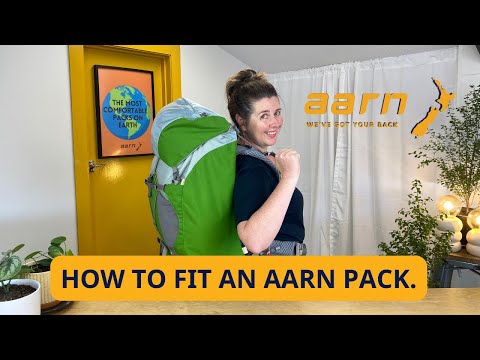
Watch this video before you try to fit your Aarn backpack, because it’s unlike any backpacking backpack you’ve tried before.
A blue loop at the bottom of the pack connects to the top of the frame, such that when you pull down on the backpack, it pulls the frame down until the shoulder straps are resting securely and comfortably on your shoulders.
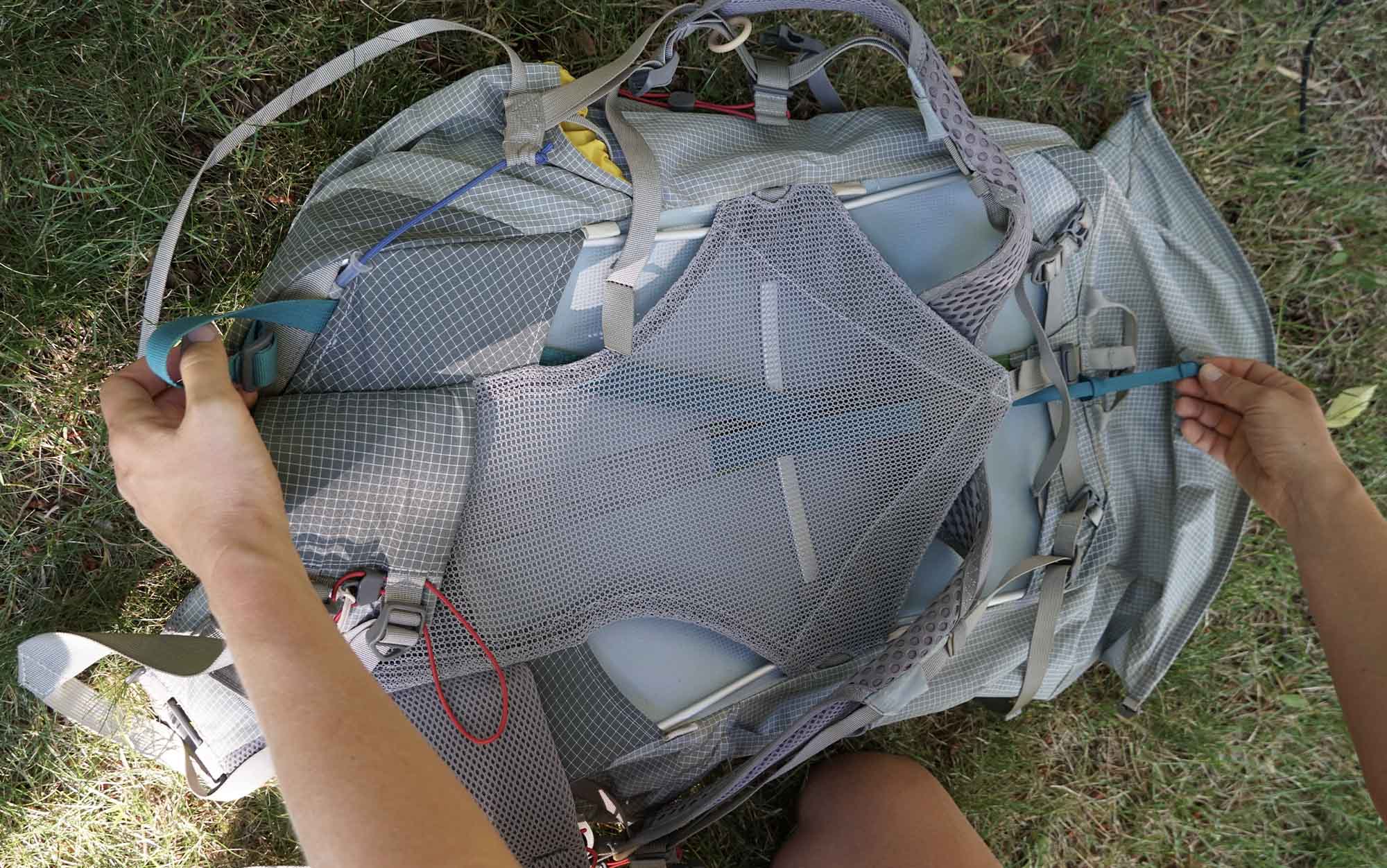
Alex Robinson
This shift in the order of operations for fitting a pack made a huge difference in our testers’ ability to adjust the backpack to their frame — it earned nearly perfect marks in this category with only the tester with the shortest torso deducting one point for fit. One reason for this is that by ensuring a perfect fit of the back panel, the load was already balanced between their hips and their shoulders before even getting to the load lifters. “I found that I didn’t need to do much adjustment to these because the weight was distributed so well,” noted Steady, who carried 36 pounds and experienced zero discomfort.
U-Flow System
Typically, once you’ve got an internal frame backpacking backpack strapped on, your range of motion is going to be somewhat limited. Try to swivel your hips, and the pack will resist you. Try to move your shoulders up and down, and the pack will resist you. That’s partly why frameless packs have become so popular with the fastpacking set — they allow for the greater range of motion needed to run and scamper and break FKTs.
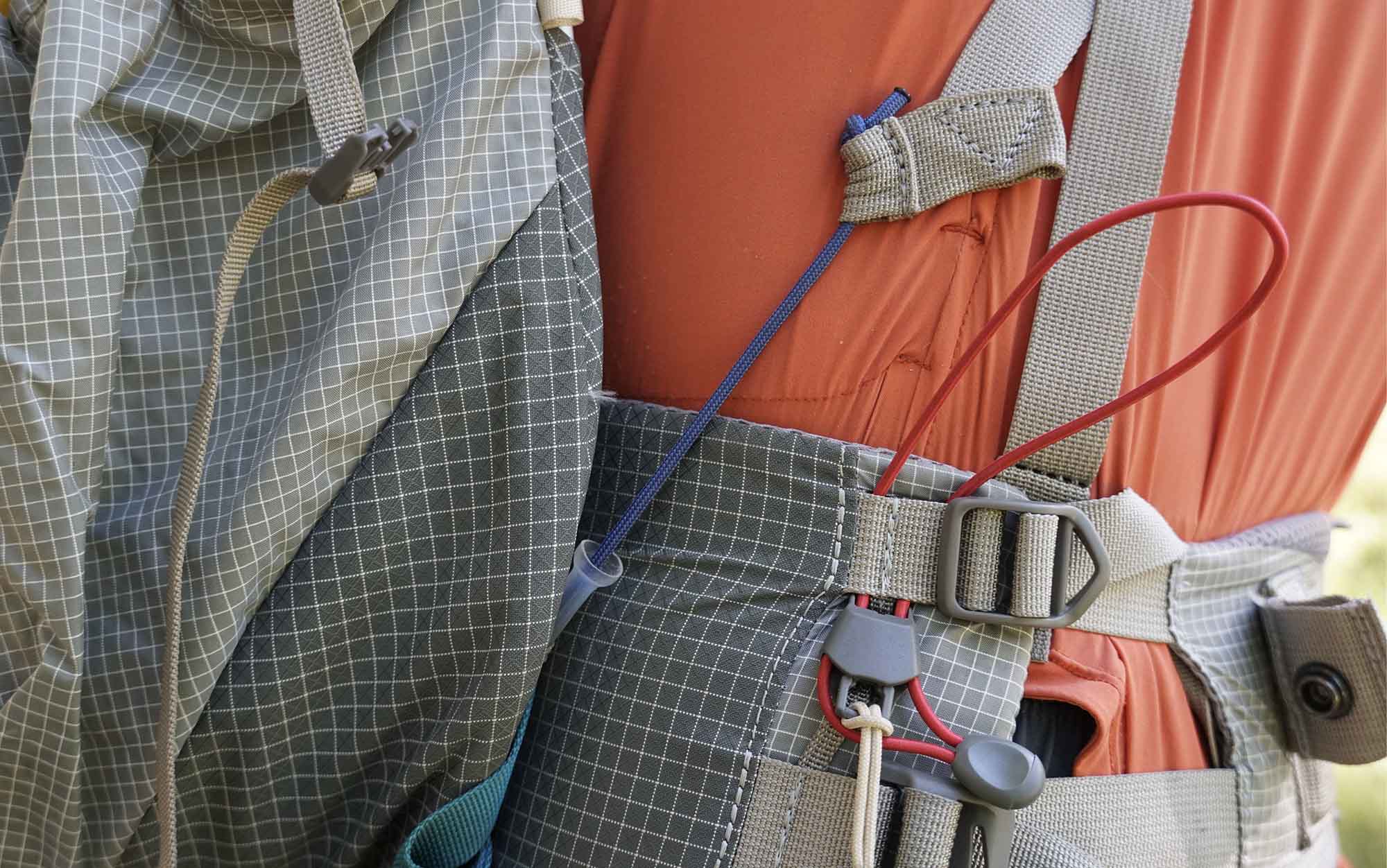
Alex Robinso
But the Aarn Mountain Magic Pro allows for a similar range of motion, while still transferring plenty of weight to your hips via metal stays in the frame. That’s because the shoulder straps aren’t stitched into the back panel. Instead, the top of the shoulder straps are attached to the back panel adjustment mechanism at the top and a nylon cord running between the bottom of the shoulder straps that’s tucked into the bottom of the back panel. When you swivel your hips, the pack moves with you. When you move your shoulders up and down, the pack is along for the ride.
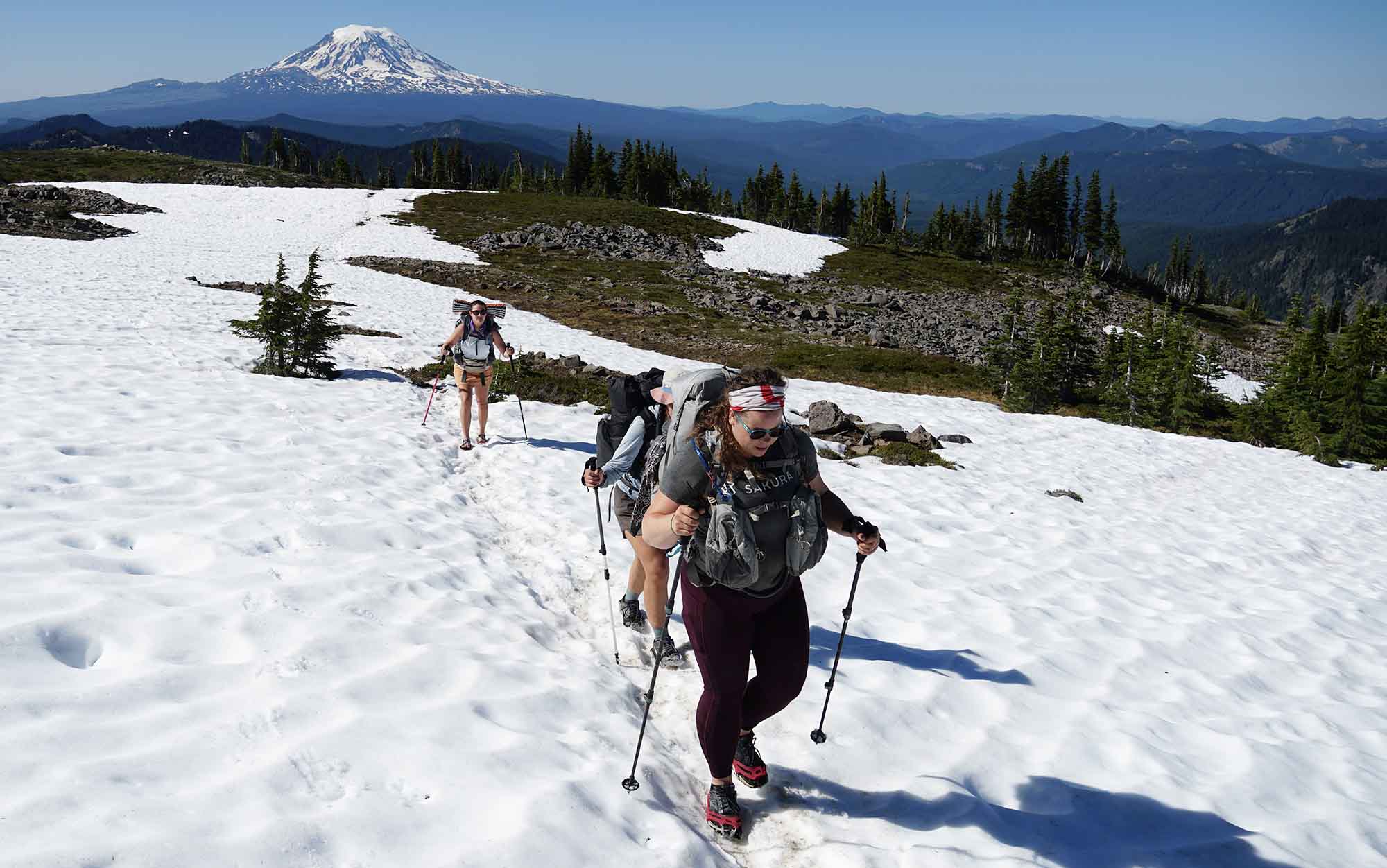
Alex Robinson
I’m forever turning around while hiking to talk to the person behind me on testing trips. With the rigid frame backpacks I tested, a nagging piriformis injury would flare each time I tried to do this, but I was completely pain-free in the Aarn Mountain Magic Pro. Other testers noted feeling similarly free: “The way the Aarn Mountain Magic Pro moves with you makes you feel limber, solid, flexible in a way that no other pack has made me feel,” said Helmuth.
Balance Pockets
The most visually striking part of the Aarn Mountain Magic Pro are the balance pockets on the front. While front shoulder pockets are becoming increasingly common on backpacks, these pockets take it to a new level. Most of the testers for this pack struggled to make a dent on their 7-liter capacity. “With three separate compartments on each side — one mesh and two interior zippered pockets — I would be able to access just about anything quickly,” said Steady. “Some of the things I would like to have more accessible in my daily guiding would be my binoculars, wildflower field guides/books, reading glasses, sat device, bug spray, sunblock in addition to the things I usually put in my hip belt pockets like snacks.”
When it was my turn to test this pack on the final leg of our trip, I tried to put everything in there that I could think of, and there was still plenty of room to spare when another hiker (testing the minimalist Symbiosis pack) who needed me to hold her sunglasses case. I even plunked my liter gatorade bottle in the front mesh pocket and barely noticed a thing.
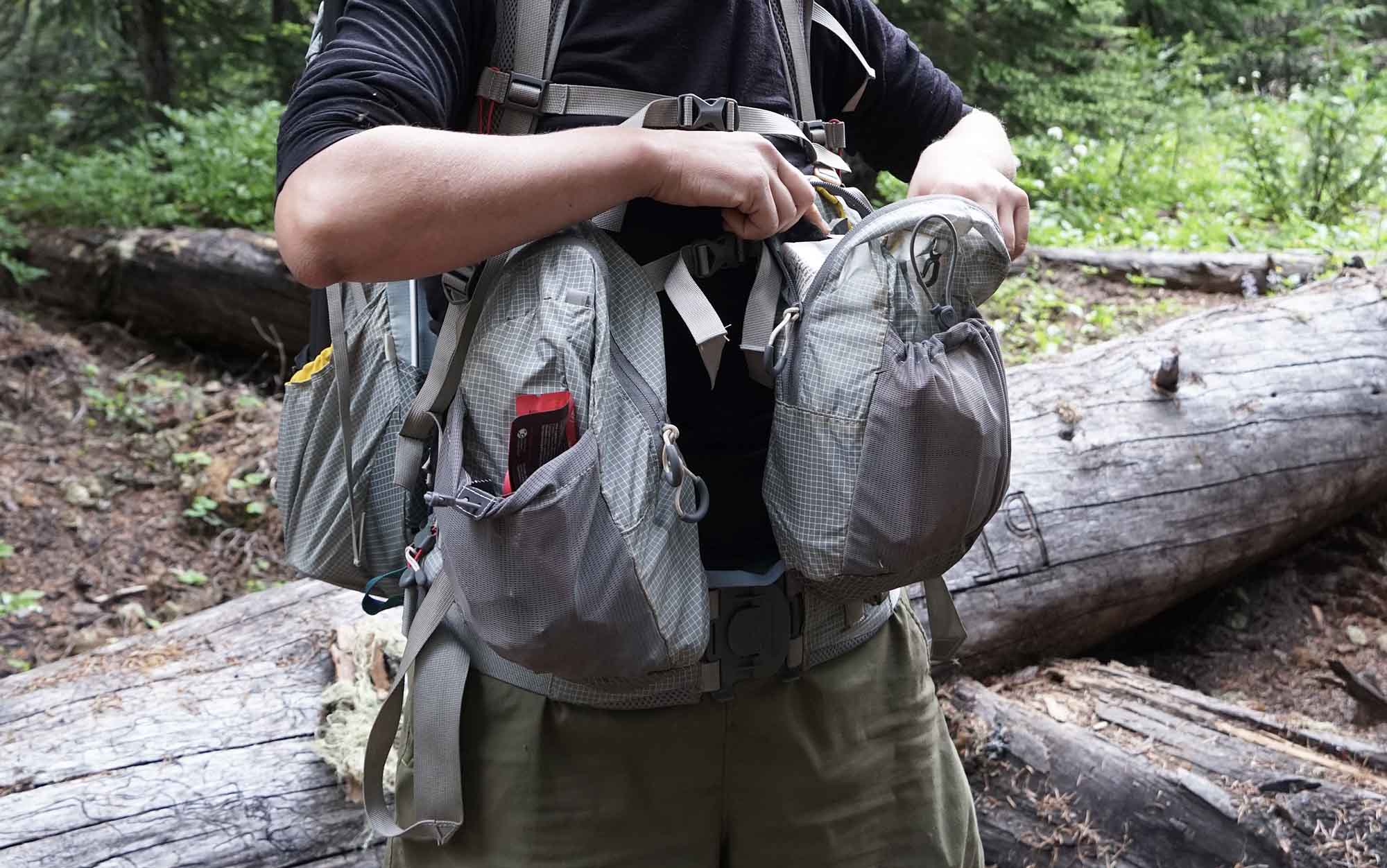
Alex Rob
And that’s the thing about the balance pockets: You can load them up and still barely notice the added weight. But, you have to be brave enough to do so because — by American standards — they look ridiculous. So ridiculous in fact, that we took the pockets off at one point to make sure that the benefits of the back panel adjustment and U-flow harness stayed intact even without the balance pockets (they do) because more than one tester stated they would not use this pack with the pockets.
The other problem with the balance pockets is that they make it difficult to put on the backpack because, fully loaded, they weigh down the shoulder straps, narrowing the gap that you have to shimmy your arm through. Some testers responded to this by simply not taking the pack off, including when relieving themselves, and found that the pack’s flexibility made this a viable option.
Six Moon Designs Swift X
Tested by Diana Helmuth on the Oregon Coast Trail with additional input from Jac “Top Shelf” Mitchell and Laura “Chop Chop” Lancaster
Report Card
- Fit: 5
- Comfort: 5
- Load bearing: 4
- Packability: 4
- Accessibility: 3
- Value: 4
Key Features
- Price: $375
- Capacity: 50 liters
- Weight: 2 pounds, 6.8 ounces
- Unisex Torso Fit: 16 to 22 inches
- Pockets: Two hip belt pockets, two side pockets, back mesh pocket, six shoulder strap pockets
- Adjustment Points: Hip belt, hip belt stabilizers, shoulder straps, back panel, load lifters, and two sternum straps
- Comfortable up to 35 pounds (as reported by testers)
- Warranty: Limited lifetime, provides repairs related to expected wear and tear for a fee
Pros
- Very comfortable
- Adjusts to a wide variety of body shapes
- Plenty of pockets
Cons
- Takes a while to fit the first few times you use it
Plenty of people just can’t get the frame and structure of a backpacking backpack — ultralight or traditional — to work for them. It’s either too stiff or too tight at the hips, pulling at the shoulders or unbalancing them at larger loads. If that sounds like you, then the Six Moon Designs Swift X backpack may have that Goldilocks configuration you’ve been after.
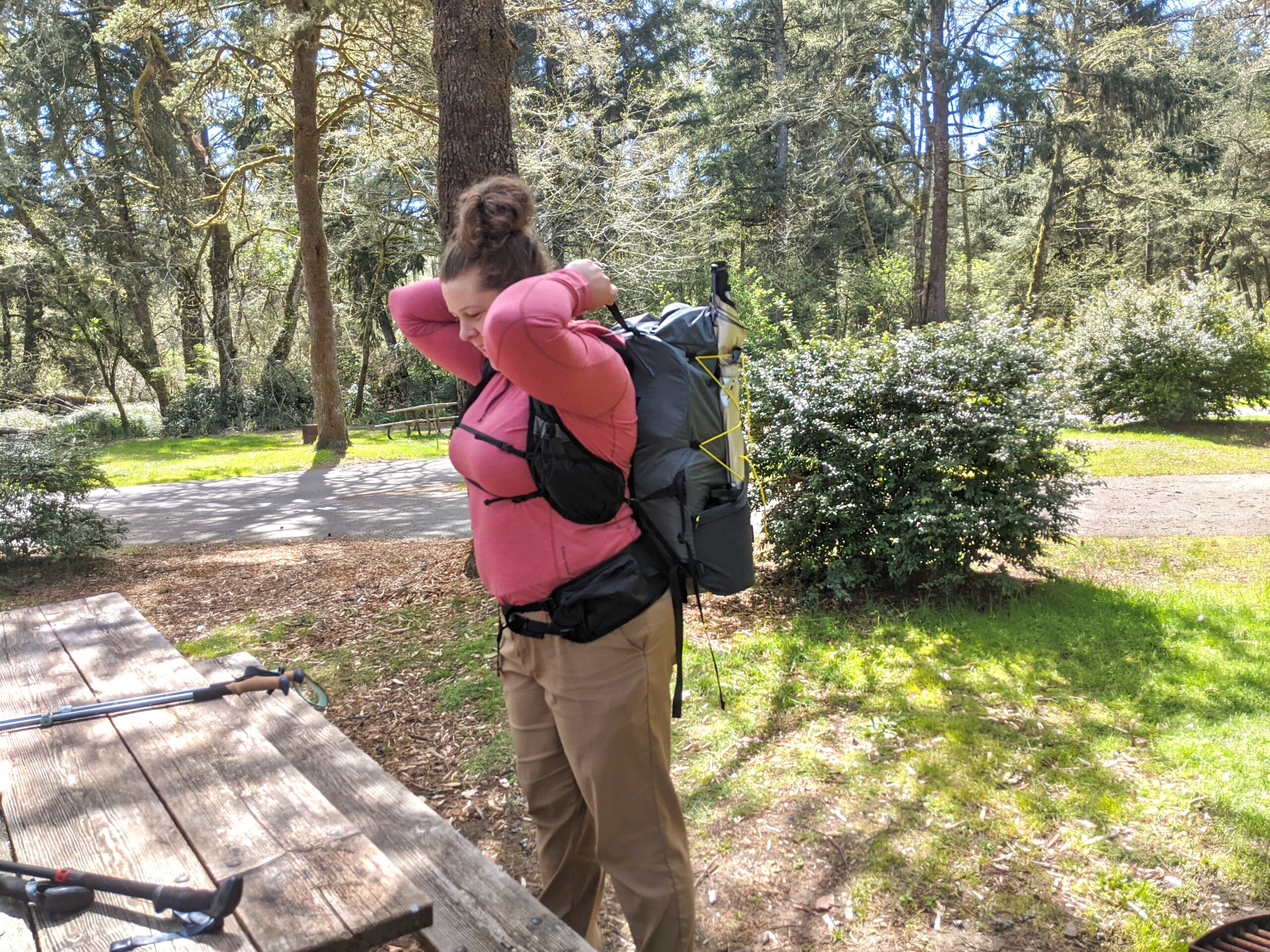
Despite being the heaviest pack we tested on our Oregon Coast Trail testing trip, the Six Moon Designs Swift X scored highly for fit and comfort. It also took advantage of the wide running vest harness by adding three pockets onto each side, the most of any backpack that we looked at in 2023.
My most experienced tester — Jac “Top Shelf” Mitchell — had discussed Six Moon Designs vest-style backpack when we interviewed her in the fall of 2022. Unlike traditional backpacks or framed ultralight backpacks that tend to perch weight on your hips and shoulders, the vest style of backpack conforms more closely to your body, almost hugging you (Six Moon also offers this backpack with a more traditional strap configuration). We were curious to see what Diana Helmuth, an ultralight skeptic who swears by her decades-old Dana Designs backpack, would think. Would she miss the more robust internal frame?
Nope. “I had 5 liters of water in that thing, plus the rest of my gear, and I couldn’t believe how my shoulder and hips felt,” she reported. “That was a big eye opener for me compared to my experience with a beefy internal frame.”
I was similarly impressed with the Six Moons Designs pack, particularly the running vest straps, when I took this one out into the field. Unlike other ultralight packs I’ve used, this one felt like it had a fully supported frame that was also comfortable to use. And the strap system seemed to work equally well on a wide range of body types — a very thin woman stopped me on my hike and asked about the pack. I helped her adjust it and she said that it was one of the most comfortable packs she had tried.
Best Backpacking Backpacks: Removable Frames
Best Overall: ULA Circuit
Tested on the Oregon Coast Trail by Laura “Chop Chop” Lancaster, Patrice “Steady” La Vigne, and Diana Helmuth
Report Card
- Fit: 4.7
- Comfort: 3.9
- Load Bearing: 4.7
- Packability: 4
- Accessibility: 3.7
- Value: 4
Key Features
- Price: $300 ($380 in Ultra)
- Capacity: 68 liters
- Weight: 2 pounds, 5.3 ounces (2 pounds, 1.8 ounces in Ultra)
- Unisex Torso Fit: 15 to 24 inches
- Pockets: Two hip belt pockets, two side pockets, one large back pocket
- Adjustment Points: Hip belt, shoulder straps, load lifters, sternum strap
- Comfortable up to 40 pounds (as reported by the testers)
- Warranty: Lifetime
Pros
- Available in high-performing Ultra fabric or more cost-effective Robic
- Can handle large, heavy loads while scaling down for smaller carries
- Wide range of sizing options makes it easier to get the right fit
- Customizable if you want bottom straps, ice ax loops, etc.
Cons
- Limited pockets compared to other models we looked at
There was some controversy with this one. ULA is a mainstay of the ultralight backpacking world, and their packs are regularly seen on long trails across the country. In a lot of ways, they epitomize what ultralight packs are all about: ULA packs pare away everything but the bare essentials. They test the limit of how little structure and frame you can get away with across a range of load weights. They’re tough and durable enough to go the distance on not one but multiple thru-hikes.
ULA also has a lifetime warranty, and — unlike other so-called warranties — thru-hikers have reported that ULA stands by their policy. (One Triple Crowner told us for our story on the best thru-hiking backpacks that ULA offered to send her a brand-new pack after the liner of her ULA Circuit wore down.) The ULA Circuit was also the only pack we looked at where you could choose to keep the price down with the time-tested Robic fabric or upgrade to the best-in-class Ultra, a $100 price difference.
Ultra is a comparatively newer fabric in the ultralight landscape, that meets or exceeds the durability and waterproofness ability of other best-in-class fabrics while weighing significantly less. It’s also significantly more expensive. We tested a number of packs that used this fabric, including the Durston Kakwa 40, the Palante Desert, Outdoor Vitals CS40, and Zpacks Ultra Arc Haul. One difference with the ULA Ultra Circuit is that in addition to using Ultra 200 (as opposed to 100) on the body of the pack, the bottom is reinforced with Ultra 400 for extra durability. Whether the weight savings (and promised waterproofness) of the Ultra material is worth the extra cost is ultimately a matter of preference — either option would be an excellent choice that would serve you well for multiple thru-hikes.
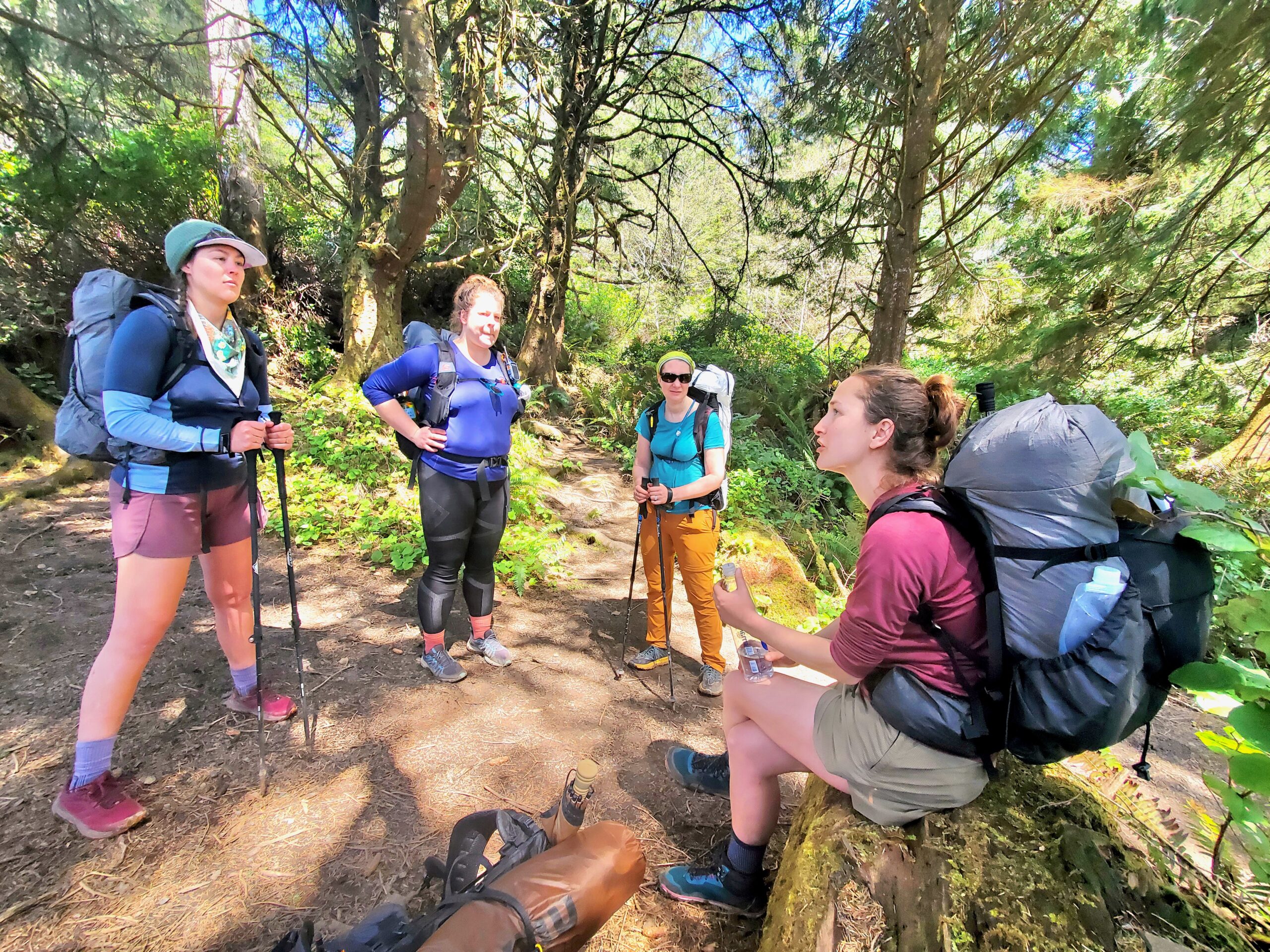
The level of support the ULA Circuit provides is perfect for 30-pound loads, and even up to 40-pounds in the event of a long water carry. While some backpacks in this weight category dispense with any sort of frame or structure to the back panel, the ULA Circuit has a hoop running along the outer edges up across the top of the back mesh panel and then meeting again at the bottom. This provides an exceptional level of support for its minimalist design. We had one tester, Diana Helmuth, who is new to ultralight-style gear (she typically uses traditional backpacking backpacks, like the Deuter Aircontact) and she reported that the ULA Circuit caused her zero pain points and was similarly amazed at how well this pack handled the load.
I used the ULA Catalyst (the big brother to the Circuit) years ago on a thru-hike of the Pacific Crest Trail, but hadn’t picked up a ULA since. When it was my turn to test the ULA Circuit on the third day of testing I was surprised by how much I still liked this style of pack. It swallowed all my gear and cinched down effortlessly around it. The shoulder straps and hip belt were cushioned without overdoing it; the back panel was firm without being stiff. Even though it was the third day of testing, it was the most comfortable carry of the whole testing trip. If I was heading out on a trip with a significant load tomorrow, this is the pack I would bring with me.
When I asked associate gear editor, Ashley Thess, if she would be trading in her current ULA pack (an Ohm) for any of the lighter models she tried out during testing, the answer was a resounding no. Part of what makes the ULA packs so popular is that they are both a great entry-level ultralight backpack and a great choice for the third hike of your Triple Crown.
But not everyone loved it, including Steady, who has completed both the Appalachian and Te Araroa Trails. For her, the comparatively minimalist pockets and access points on the ULA Circuit disrupted her system for packing and accessing gear on trail — and the weight savings of the pack didn’t make that worth the headache. Other testers noted, too, that the pockets on the ULA Ultra Circuit that we tested had less give than other backpacks we looked at (including the Robic version of ULA’s packs).
Something the ULA Circuit drove home for this testing group is that the switch to ultralight-style backpacks is not just about cutting weight from your kit; it’s about reimagining your relationship with your backpack and, by extension, your gear. Most of us that spend significant time in the backcountry have developed countless routines that we barely register: how we prep our coffee in the morning, how we organize the inside of our tents — and how we get into and out of our backpacks. These routines aren’t small things; they are what keep us going on days when 20 mile per hour wind is sandblasting you in the face (as happened on the second day of our testing trip).
So if Patrice’s frustrations with the top-entry-only access and scant pockets of the ULA Circuit resonate with you, then our recommendation is to look at one of the options on this list with more traditional-style pockets, such as the Granite Gear Crown3 or Osprey Exos.
But if you’re prepared to really rethink your relationship to your backpack, then we think the ULA Circuit is the place to start. All our testers were impressed with how comfortable it was, even with heavier loads, both compared to traditional-style backpacks and compared to other ultralight models we looked at. So even if you’re just getting started on your ultralight journey, and haven’t yet upgraded to the best ultralight tent or the best ultralight quilt, this pack will work for the kit you have now, and the kit you have in the future. Plus its warranty-backed durability means that you may never need to switch it out.
Hyperlite Southwest 40
Tested on the Oregon Coast Trail by Ashley Thess with additional input from Jac “Top Shelf” Mitchell
Report Card
- Fit: 4
- Comfort: 4
- Load bearing: 5
- Packability: 4
- Accessibility: 4
- Value: 3
Key Features
- Price: $350
- Capacity: 40 liters
- Weight: 1 pound, 14.8 ounces (1 pound, 15.9 ounces for DCH150)
- Unisex Torso Sizes: XS to L (15 to 21 inches)
- Pockets: Two hip belt pockets, two side pockets, one large back pocket
- Adjustment Points: Hip belt, shoulder straps, sternum strap
- Comfortable up to 25 pounds
- Warranty: One year
Pros
- Available in brick and mortar stores
- Lightweight
- Great load bearing for its weight
Cons
- Expensive
- Sternum strap was abrasive to our tester
- Limited warranty
Hyperlite is one of the most well-known names in ultralight gear, and it’s one of the few sold in brick-and-mortar stores. So we were curious to see how it would stack up next to the cottage companies. If you try out a Hyperlite pack in an REI and love it, does that mean you should go ahead and buy it? Or would it be better to take a gamble on another pack in this list?
After testing the Hyperlite Southwest 40, we feel confident that you should trust your gut and buy that Hyperlite if you like it in the store. It’s comfortable even with the heavier end of ultralight loads (one tester carried 24 pounds in this pack over 15 miles). Despite having only two aluminum stays and no load lifters, Thess said she was able to forget about the pack on her shoulders — the highest of praise, in our opinion.
It also scored high for its accessibility, as it had all of the pockets (two hip belt pockets, two side pockets, and a giant back pouch held closed with an elastic band) we look for from an ultralight backpack, and none of the ones that add extra weight without increasing functionality.
One thing to note is that, unlike the other ultralight backpacks at this price point, the Hyperlite is made from DCH rather than Ultra. DCH is a laminated version of Dyneema Composite Fabric (DCF), which has many of the same qualities as Ultra. The only concrete difference between the two is that DCH tends to look the worse for wear over time, although its performance is typically unaffected.
So what are the downsides of this pack? It’s a few ounces heavier than the other packs in Ultra that we looked at (although lighter than the more frame-intensive ULA Circuit). Despite their widespread availability and ubiquity, there isn’t the option to switch to S straps (although our tester did note that the J straps were less extreme than on other ultralight backpacks). The sternum strap is also only minimally adjustable, and for Thess it was pitched too high. She reported needing to stash a bandana underneath to prevent chafing. Finally, it has a limited warranty — only one year.
Black Diamond Beta Light 45
Tested in the Goat Rocks Wilderness by Adam Tycaster, Alex Robinson, and Ashley Thess
Report Card
- Fit: 3.3
- Comfort: 2.7
- Load Bearing: 3
- Packability: 4.7
- Accessibility: 4
- Value: 2
Key Features
- Price: $400
- Capacity: 45 liters
- Weight: 2 pounds, 5 ounces
- Unisex Torso Fit: 14 to 21.5 inches
- Pockets: Two side stretch pockets, back mesh pocket, two hip belt zip pockets, two zip and two mesh shoulder strap pockets
- Adjustment Points: Attached hip belt, shoulder straps, load lifters, two sternum straps
- Comfortable up to 25 pounds (as reported by the testers)
- Warranty: Limited lifetime
Pros
- Made out of Ultra, which is waterproof and extremely durable, and seam taped
- Holds a surprising amount of gear for its size and weight
Cons
- Expensive
- Uncomfortable shoulder straps (need to be wider)
Black Diamond is a big name in climbing and skiing, but less popular among backpackers. But having used the Black Diamond Trail Zip (one of my best hiking daypacks), I know they understand the nuances of how load is carried on the body. I was excited to see what they had come up with for the lightweight-set.
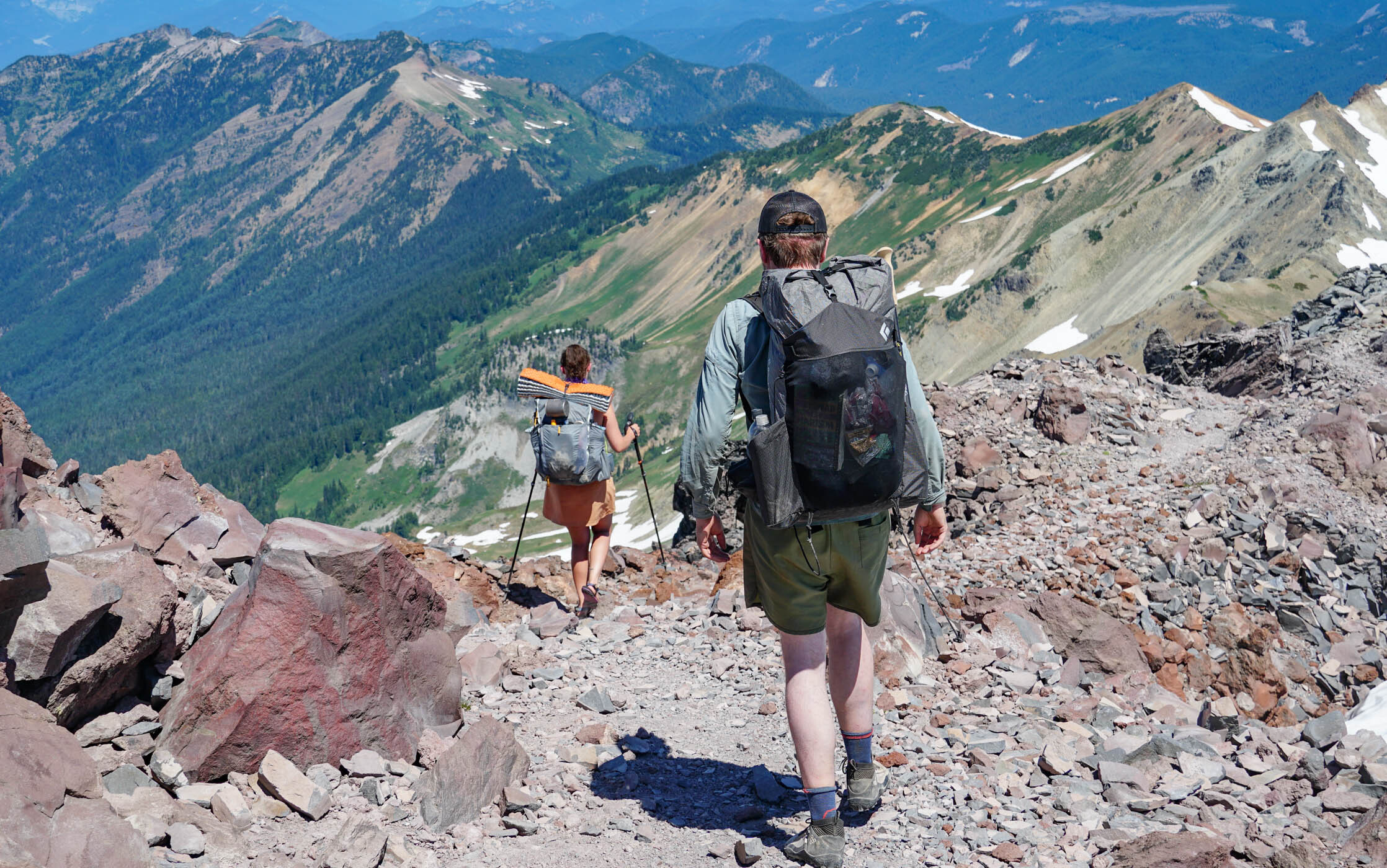
Alex Robinson
Our testers came away impressed with how well this backpack fit large loads and compressed them down into something that was tidy and manageable. The first tester for this pack was OL’s own editor-in-chief, Alex Robinson, who hiked up 2,000 feet from the trailhead over four miles to intersect with the rest of the crew in the Goat Rocks Wilderness. Robinson was new to lightweight backpacking, so I wasn’t sure what to expect with a pack loaded up with a backpack hunter’s kit (plus photography equipment and whiskey).
But it turns out this backpack had plenty of space, even for an ultralight novice. “Overall, the pack had plenty of storage space and lots of nice pockets on the hip belt, shoulder straps, and interior that I liked,” he reported. Other testers agreed, although they noted that the amount of usable space in the back pocket is restricted by the amount you pack into the main compartment. Thess especially appreciated the shoulder strap pockets which were the perfect size for sunglasses, a phone, and snacks.
The other two male testers, however, noted its narrow running-vest style profile cut into their shoulders at loads of 35 pounds and 25 pounds. Thess, who does a lot of trail running, enjoyed the flexible mesh over some of the stiffer padded options in our test. Though, she found herself wishing the hip belt was wider.
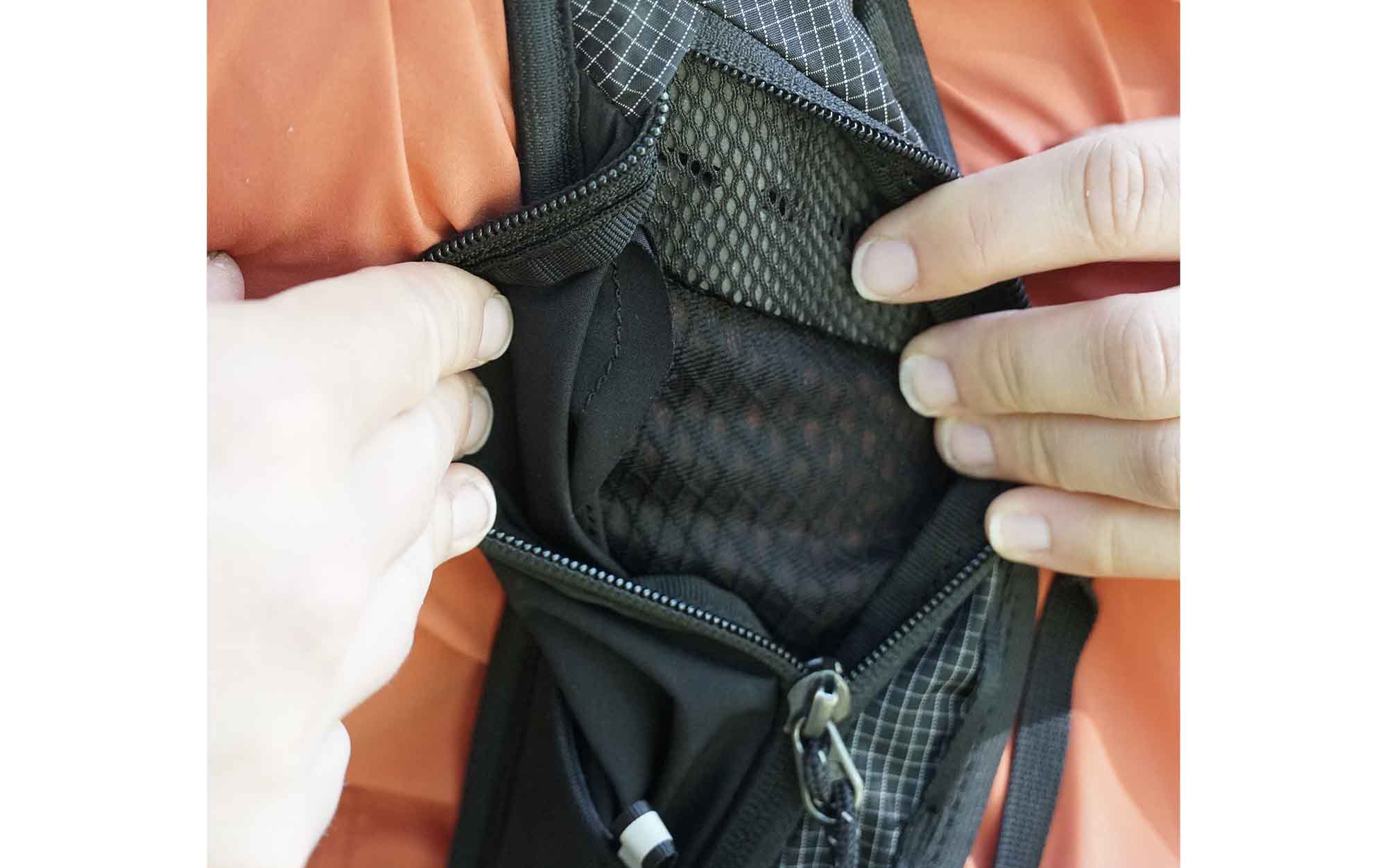
Alex Robinson
Other packing features were minimal. It has a simple roll-top closure (top buckle only) with a single compression strap running to the top. There are two removable compression bungees on the sides that testers noted were too high to really slim down a bulky pack. (The shallow depth of the side pockets fortunately meant they weren’t as important for securing water bottles or trekking poles in place. Unusually, the Black Diamond Beta Light 45 comes with under-carriage straps, but this gear writer suspects most people who use this pack will remove them.
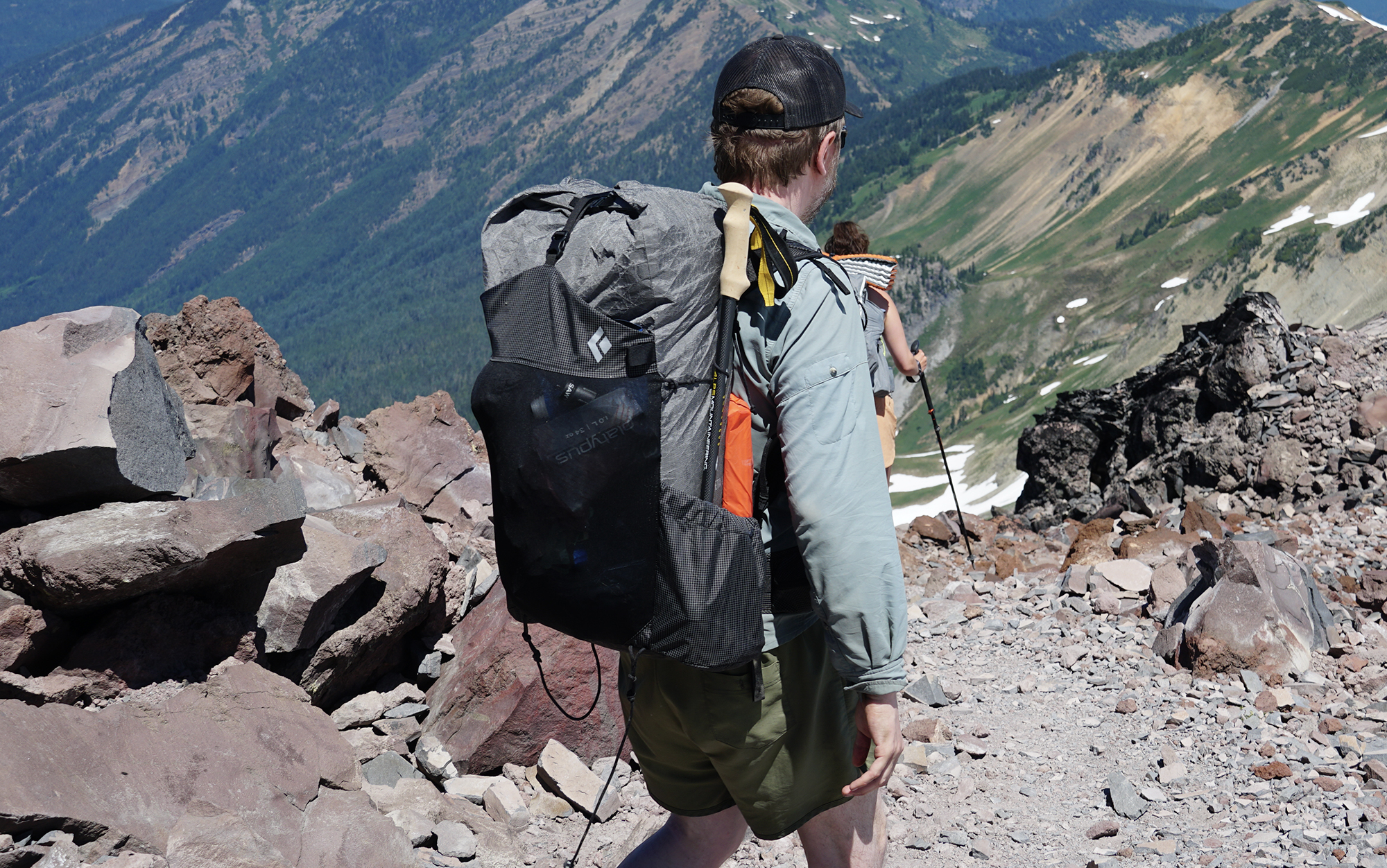
Alex Robinson
Testers were mixed on the fit on this pack. It received middle-of-the-road marks for load bearing (all three testers kept the aluminum stays in) and lower than average marks for comfort due to the narrow shoulder straps. One bright note was the load lifter straps. These were, by far, the longest load lifter straps in our test, possibly the longest I had ever seen. But, there was also a small triangle of fabric between the load lifters and the connection point on the straps. I liked this, because it gave testers all the satisfaction of really cranking down on the load lifters without running into the all-too-common problem of overdoing it and ending up with a pack that’s pulling too hard on their shoulders or hitting them in the back of the head.
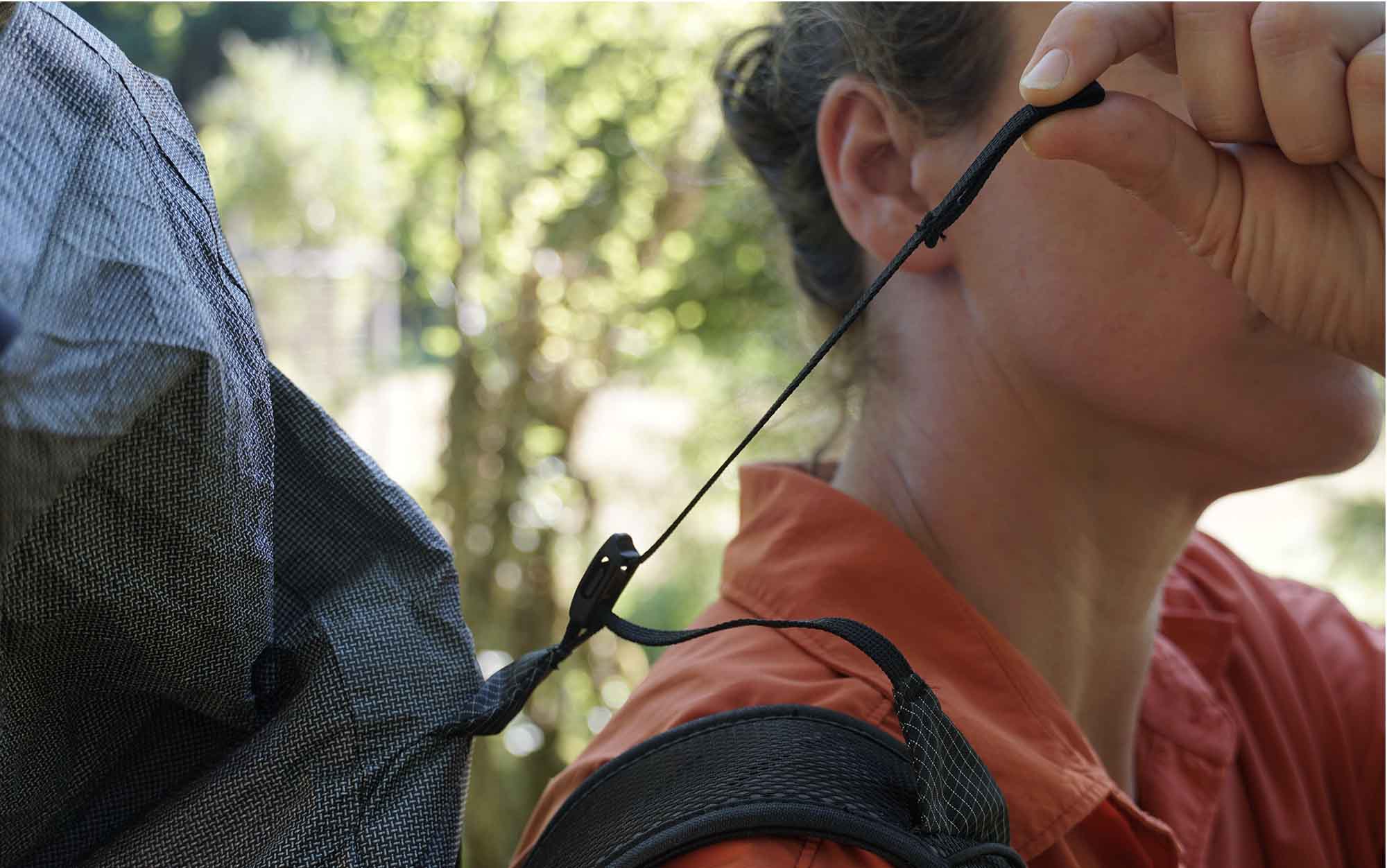
Alex Robinson
Ultralight backpackers will also appreciate that this pack is made from Ultra, a best-in-class backpack material that is extremely durable and waterproof. Moreover, the inside of the pack has been seam-sealed, so the thing ought to be, at least at the start, fully waterproof. (Our testing trip was unfortunately completely dry). Backpackers should still use caution, and at least bring a trash compactor bag for their gear, in the event this feature fails in the field.
Durston Kakwa 40
Tested on the Oregon Coast Trail by Jac “Top Shelf” Mitchell and Ashley Thess with additional input from Laura “Chop Chop” Lancaster
Report Card
- Fit: 2
- Comfort: 2
- Load bearing: 3
- Packability: 3
- Accessibility: 4
- Value: 4
Key Features
- Price: $250
- Capacity: 36 liters
- Weight: 1 pound, 11.3 ounces
- Unisex Torso Fit: 14.5 to 21.5 inches
- Pockets: two hip belt pockets, two side pockets with vertical zip pocket on the left side, back mesh pocket
- Adjustment Points: Hip belt, shoulder straps, load lifters, sternum strap
- Comfortable up to 35 pounds (as reported by the testers)
- Warranty: One year
Pros
- Great pockets
- The most affordable backpack in Ultra that we looked at
Cons
- Lack of structure along the back panel requires careful packing
The Durston Kakwa 40 is an experienced ultralight backpacker’s dream. It’s lightweight (27.3 ounces for a medium). It has enough structure to manage heavier loads. It’s got all the pockets you’d expect (plus one extra). It’s made with Ultra, giving you that extra durability and additional waterproofness. And it’s extremely reasonably priced.
While the Durston Kakwa 40 has a frame that’s similar to the ULA Circuit, what it doesn’t have is a foam backing. On most of the back panel, there’s just a thin piece of Ultra fabric between you and the interior contents. Thess struggled with the lack of structure, reporting that a bulge against her back all day was annoying. Like all frameless, or unpadded, backpacks, even slightly less than ideal packing is going to result in serious discomfort. If you’re going frameless for the first time, pay attention to how you’re structuring the items in the Durston Kakwa 40.
Top Shelf, conversely, found the structure to be almost too stiff. While it wasn’t uncomfortable, it was more noticeable than other packs we looked at. After the testing trip, I loaded this pack up with about 35 pounds to see how it would handle the load. (35 pounds is what you should expect to carry in the desert with an all-day water carry but an otherwise ultralight load.) Whereas the pack hugged around my body comfortably at 15 pounds, to get the 35-pound balanced between my hips and my shoulders it had to perch more on my hips that was natural. That would be fine for a short distance (you are going to be drinking all that water, after all); this is not the pack for someone who plans to consistently carry 35 pounds.
The testers appreciated the details of the Durston Kakwa 40. Generous hip belt pockets, side pockets, and back mesh pockets (one of the few in our test that was truly see-through) made stashing items on the go a breeze. There was also a bonus zip pocket along one of the side pockets for easy access to larger items that don’t fit in your side pocket. Our only ding on the features were the side compression straps, which were somewhat difficult to tighten and release.
Best Backpacking Backpacks: Rigid Frames
Best Overall: Osprey Exos 48 and Eja 48
Tested in the Goat Rocks Wilderness by Adam Tycaster, Sven “Magic” Anderson, Alex Robinson, and Diana Helmuth
Report Card
- Fit: 4.25
- Comfort: 4
- Load Bearing: 4.25
- Packability: 4
- Accessibility: 3.5
- Value: 5
Key Features
- Price: $240
- Capacity: 48 liters
- Weight: 2 pounds, 12.7 ounces
- Men’s (Exos) Torso Fit: 17 to 23 inches
- Women’s (Eja) Torso Fit: 13 to 19.5 inches
- Pockets: Removable top lid pocket, two side stretch pockets, back mesh pocket, two hip belt zip pockets
- Adjustment Points: Attached hip belt, shoulder straps, load lifters, adjustable back panel, sternum strap
- Comfortable up to 35 pounds (as reported by the testers)
- Warranty: Lifetime guarantee
Pros
- Best-in-class load bearing
- Unparalleled back panel ventilation
- Removable top lid pocket makes this a good option for those transitioning to a lightweight style
- Easy-to-use toggle system to adjust the height of the back panel
- Affordably priced
- Great warranty
Cons
- Too-tight pockets
- Fiddly compression straps
It is extremely tough to make a proper rigid-frame load-bearing backpack that comes in under three pounds, but that is exactly what the Osprey Exos is. There is no soft back panel that must be packed exactly so or soft foam that rests right up against your pack. It boasts proper aluminum stays with superb airflow across the back panel. “The Osprey was a very comfortable pack,” noted Magic. “I literally felt like I had an air conditioner on my pack.” Robinson carried this pack on the last (and longest) day, when the mosquitoes were at their worst, noting that “It rode on my back comfortably and I loved the venting.”
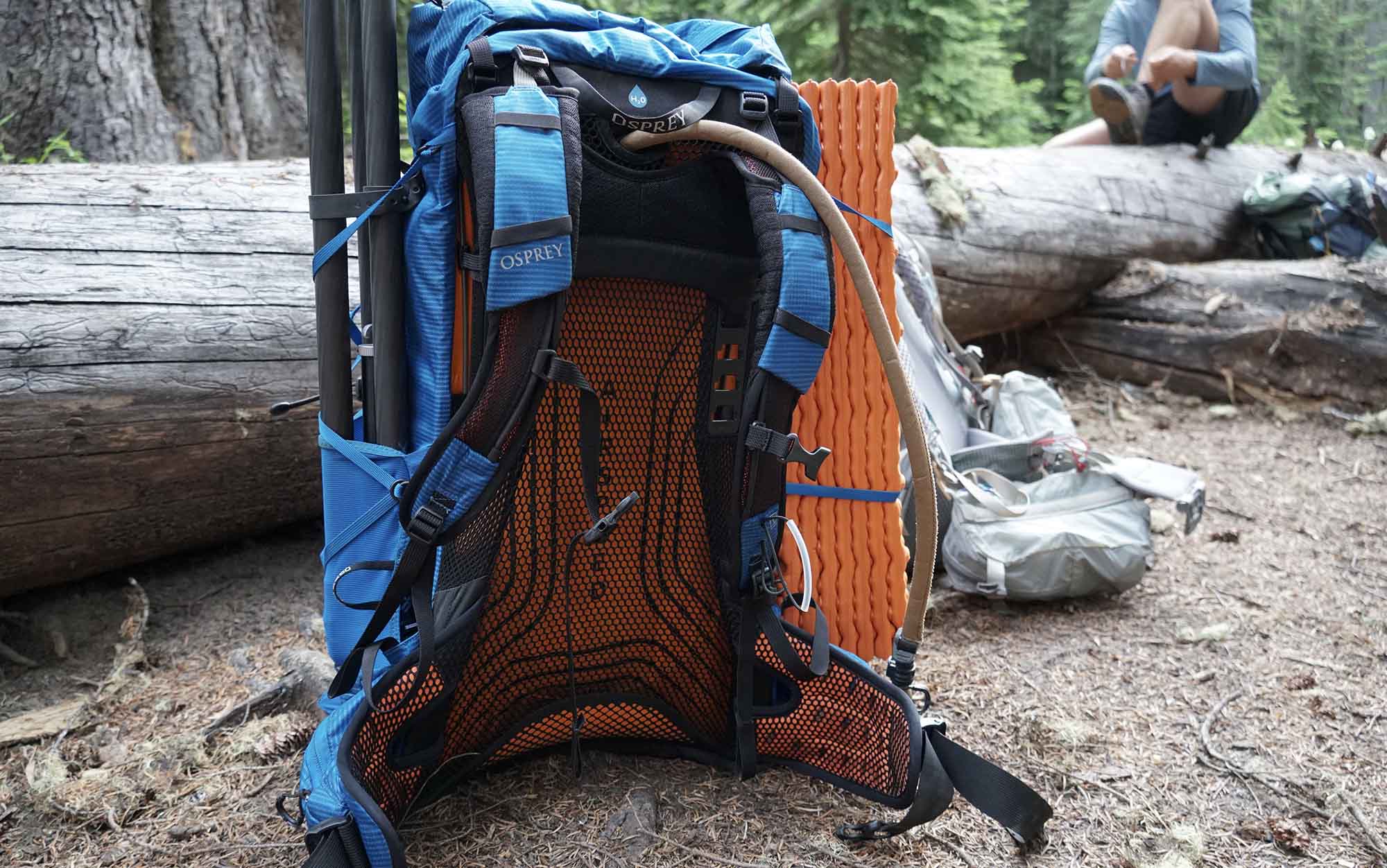
Alex Robinson
When you look at the side profile of the Osprey Exos, you can easily see the broad arc at the back panel, bracketed by the aluminum stays, that’s responsible for all that extra airflow while transferring the majority of the weight to your hips. It’s worth noting that shifting the center of the backpack’s load away from the back can, with too-heavy loads, start to pull back on the shoulders uncomfortably. However, our testers, who carried loads ranging from 25 to 31 pounds, reported no issues with the load pulling away. (Robinson did note that after carrying this backpack for over 10 miles, the bottom of the curve began to dig into his hip uncomfortably.) Testers similarly reported that the Z-shaped compression straps were a bit onerous to tighten and loosen throughout the day, but that they did their job of streamlining their load into a more aerodynamic profile.
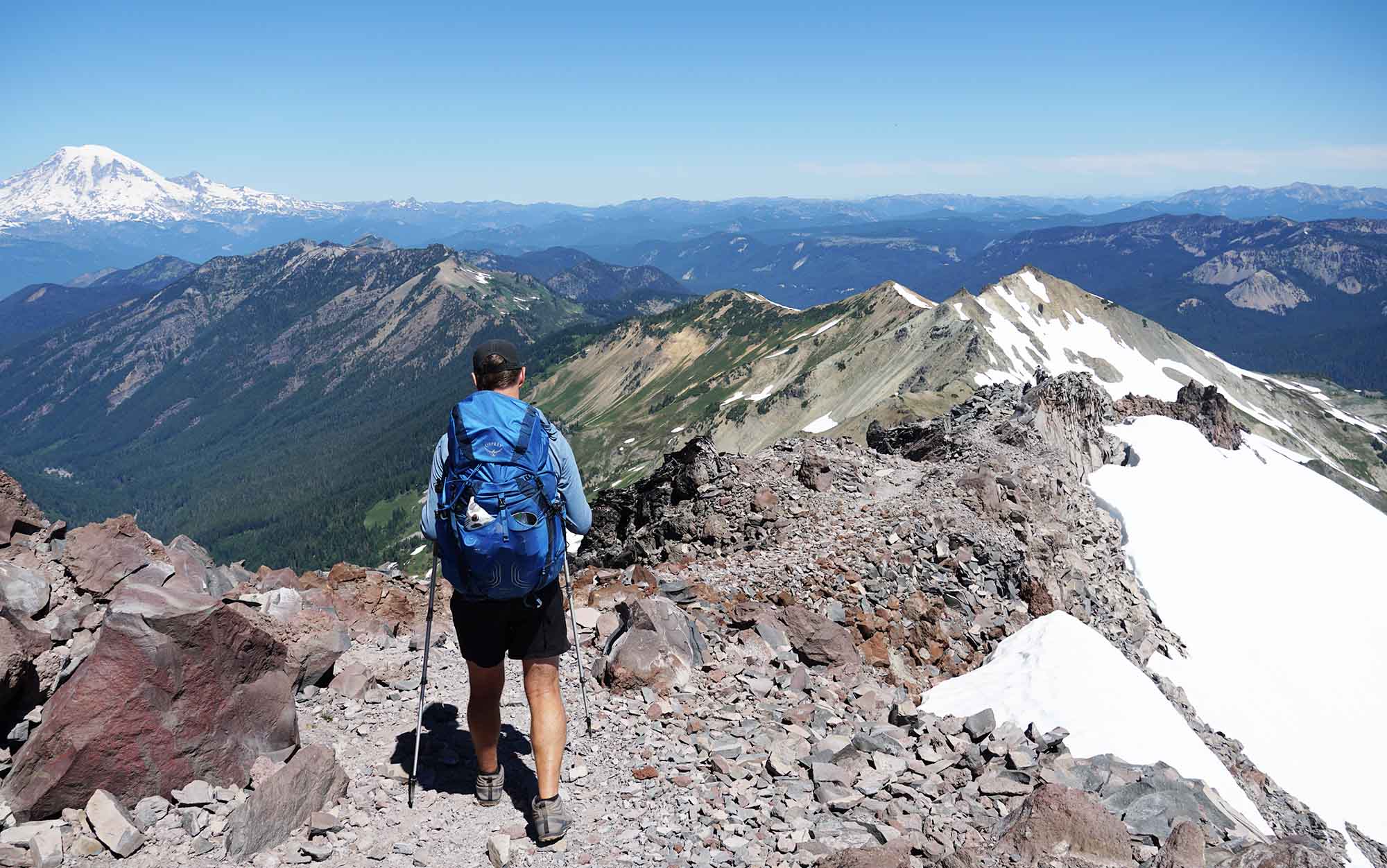
Alex Robins
What they did have issues with are the pockets. Multiple testers, including Magic, who has Parkinson’s, noted that the tight pockets on the Osprey Exos limited their ability to access gear. Helmuth also noted that the hip belt pockets rode unusually far back on her hips, limiting her ability to use them throughout the day.
One feature I appreciate about the Osprey Exos is that it has a mid-sized removable brain. For backpackers transitioning to a lightweight kit, this can help ease some of the organization retooling that comes with having fewer pockets and straps, while also ensuring they don’t unnecessarily load up the brain with heavy items (making it top heavy). Then, once they’ve got their kit truly dialed in, they can remove the brain, saving a cool 4 ounces in the process.
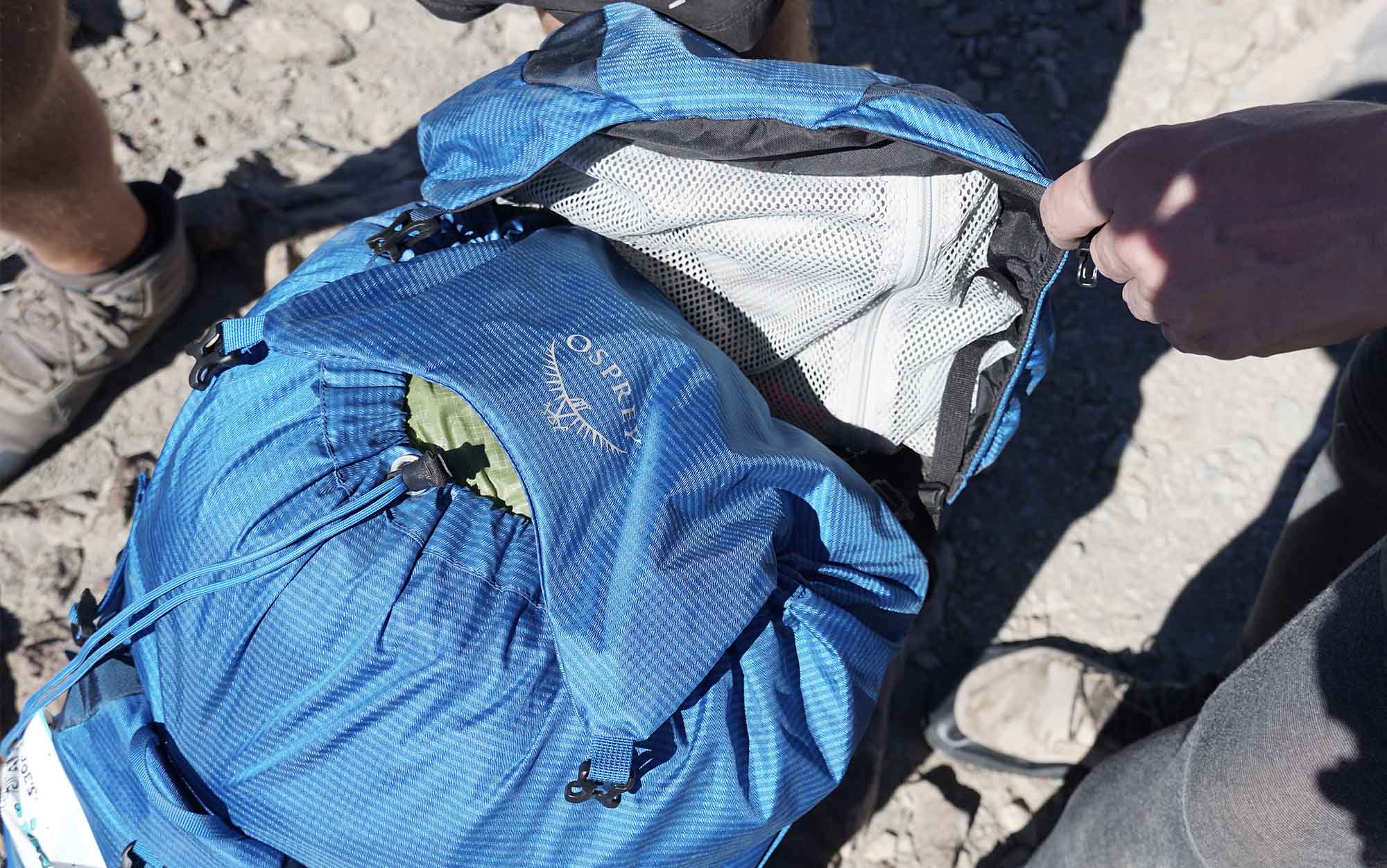
Alex Robinson
My one quibble here is that the alternative closure to this pack is a useless piece of fabric that only exists to cover the drawstring closure. Backpackers who choose to keep the top lid are then carrying around extra weight to no purpose (unless they are brave enough to cut it off permanently). And lightweight backpackers are also getting the short end of the stick as drawstring closures neither provide as much potential carrying capacity as roll-top closures, nor do they pack down smaller loads as cleanly. But these are all comparatively small complaints next to what the Osprey does best: lightweight best-in-class suspension and back ventilation.
Best for Beginners: Granite Gear Crown3
Tested in the Goat Rocks Wilderness by Alex Robinson, Patrice “Steady” La Vigne, Sven “Magic” Anderson, and Diana Helmuth. Individually field tested by Rebecca Ross, Jason Boyle, and Helmuth.
Report Card
- Fit: 3.5
- Comfort: 3
- Load Bearing: 4.25
- Packability: 4
- Accessibility: 3.75
- Value: 4
Key Features
- Price: $240
- Capacity: 60 liters
- Weight: 2 pounds, 9.6 ounces
- Unisex Torso Fit: 15 to 24 inches
- Pockets: Removable top lid pocket, two side stretch pockets, back mesh pocket, two hip belt zip pockets
- Adjustment Points: Removable hip belt, shoulder straps, load lifters, sternum strap
- Comfortable up to 35 pounds (as reported by the testers)
- Warranty: Limited lifetime
Pros
- Huge capacity and great load bearing up to 35 pounds
- Plenty of pockets for organization
- Affordably priced
Cons
- Stiff shoulder straps aggravated several testers collar bones
- Too large for smaller backpacking kits
This Granite Gear Crown3 sits at the intersection of traditional backpacking backpacks and newer ultralight models. This pack was a top pick for thru-hikers a decade ago, but has since been eclipsed by the likes of Hyperlite and ULA. But there’s still lots to love here, especially for backpackers interested in experimenting with ultralight backpacking but not interested in overhauling their whole approach to organizing their gear.
I initially sent out the Granite Gear Crown3 with backpackers that were accustomed to traditional (read: heavy and padded) backpacks to see what they would make of it. They were all impressed with how lightweight this pack was and how well it handled its max load (35 pounds). THe group praised the pockets and organization system of this pack, while noting the lack of a sleeping bag compartment took some getting used to. Unlike most lightweight or ultralight backpacks, this one not only has a removable brain, but you can even strap it around the removable hip belt to make an impromptu daypack. But testers were especially impressed with how comfortable this backpack was, with one noting that being able to position more of the pack’s weight on her shoulders helped alleviate discomfort in her hips from conventional-style backpacks.
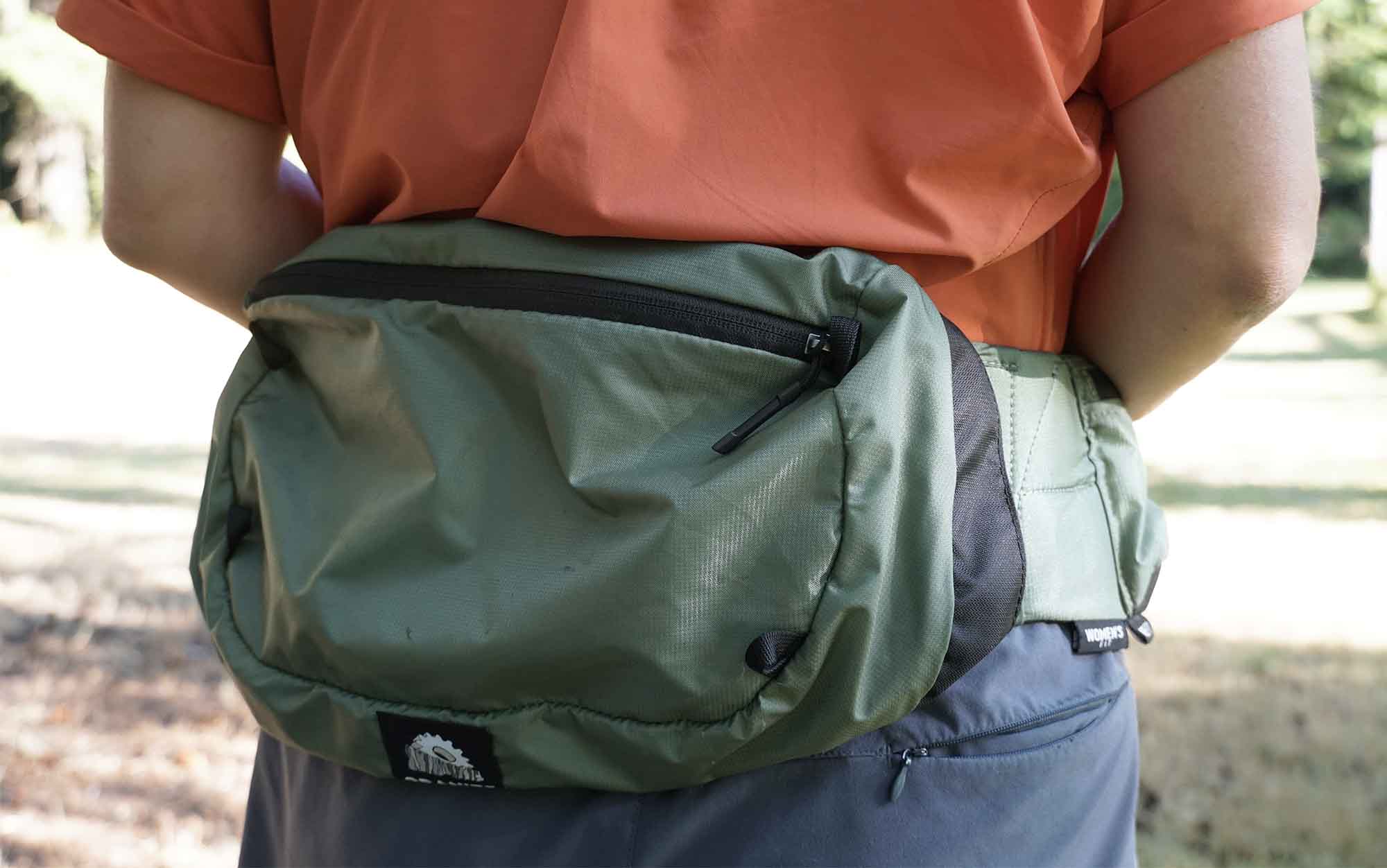
Alex Robins
The testers on the Outdoor Life backpacking gear test, most of whom are familiar with the wider range of lightweight and ultralight backpacking gear available today, were somewhat less impressed. They noted that the stiff and narrow shoulder straps had minimal padding, and testers of both genders reported feeling so much pressure on their clavicle that they were sore even in the days after using this backpack. Magic found that his gear kit, honed on over a thousand miles of the Pacific Crest Trail, took up so little room in the comparatively spacious Granite Gear Crown3 that the pack looked only half full. This, in effect, sums up the Granite Gear Crown3: Ultralight backpackers will see it as a traditional style backpack, while traditional backpackers will view it as ultralight.
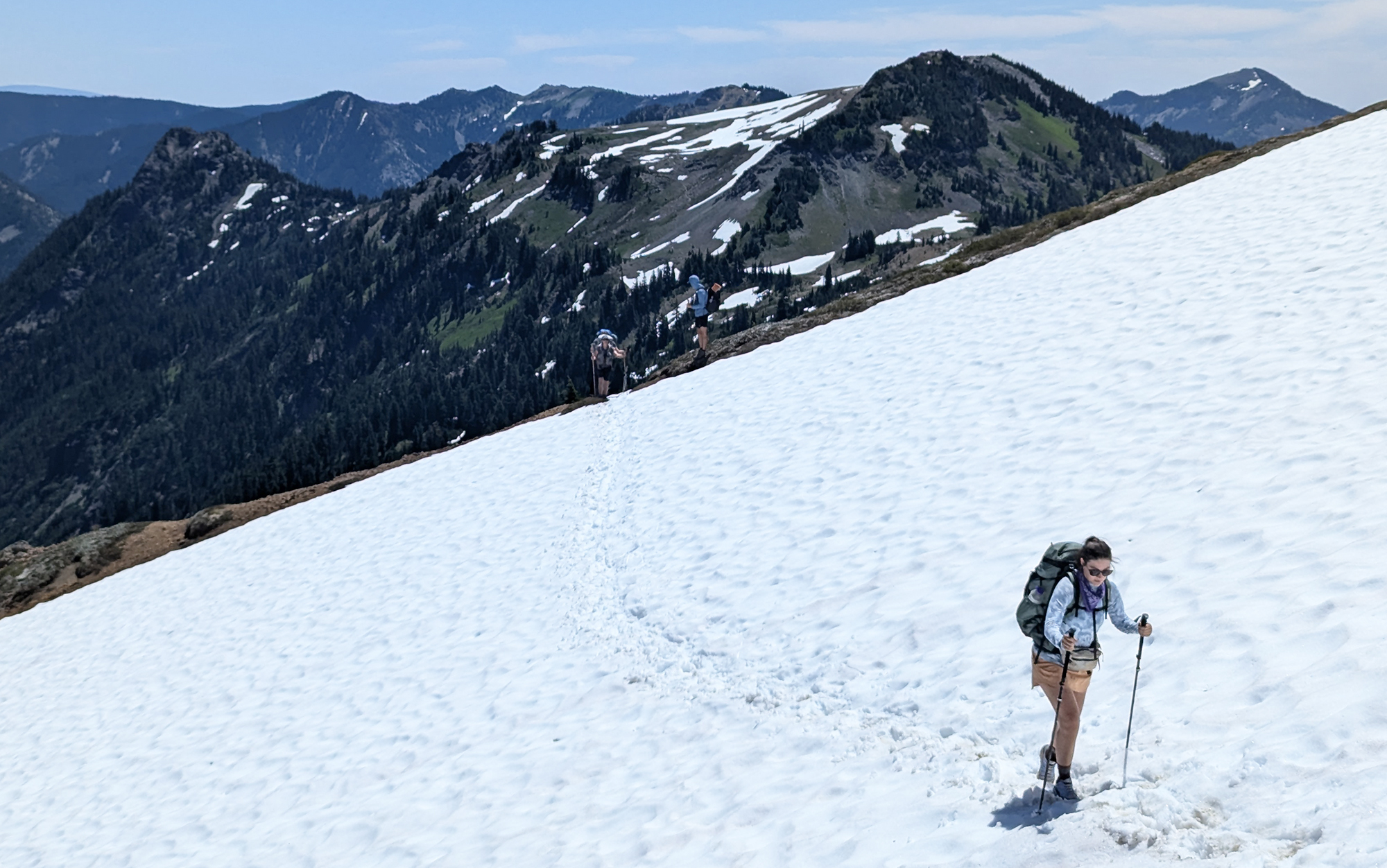
Adam Tycaster
But for those testers that had more of a maximalist backpacking style, the inclusion of so many pockets and organizational options came as a relief after using the more minimal designs. “Because I am a pocket lover, I have to praise the four pockets — one of which was the zippered brain pocket and the other three were large and stretchy, which helped with my organization,” noted Steady. “There were lots of unused features that offer even more versatility: four loops on top of the brain, two bungees on the shoulder straps, straps on the outside of the mesh outer pocket.” Even Magic praised how “the large outside pockets made it easy to get things in and out of” — helpful given the Parkinson’s he’s managing while he hikes.
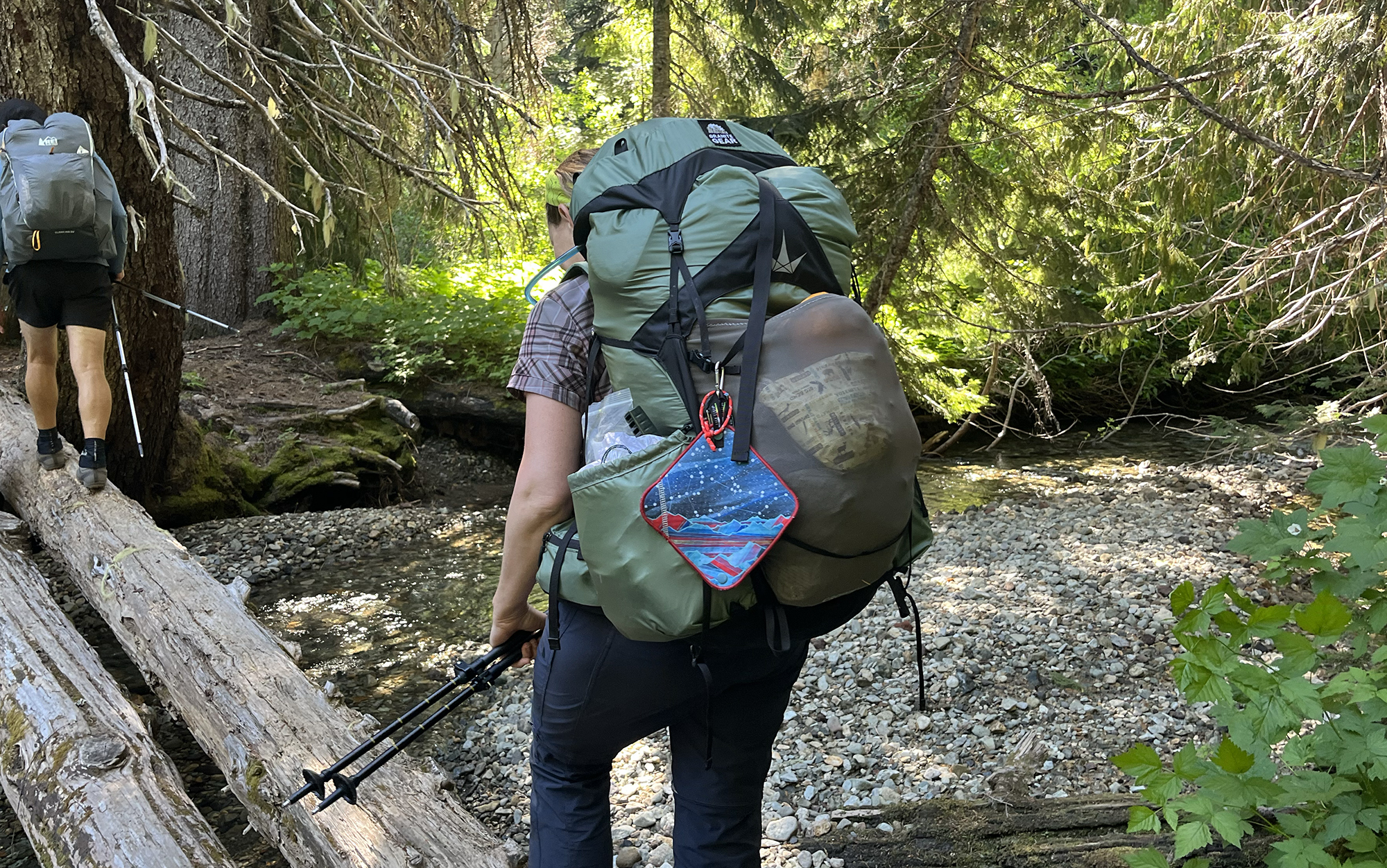
Ashley Thess
Notably missing were straps to attach gear to the underside of your backpack, but given how often backpackers use these straps for their sleeping bags (which they should absolutely never do), that is, in this gear tester’s opinion, just as well. As it was, several testers self-reported that they overloaded the generously sized brain pocket with too many odds and ends, unnecessarily top-loading their backpack. If you are looking for an ultralight backpack that will force you into a more streamlined, minimalist backpacking style, this isn’t it. But if you’re looking to save a couple of pounds off your base weight with no loss of carrying capacity, the Granite Gear Crown3 remains one of the most cost-effective options out there and should go straight to the top of your list.
Read Next: How to Pack a Backpack
Mystery Ranch Bridger 65
Tested individually by Rebecca Ross, Jason Boyle, and Diana Helmuth
Report Card
- Fit: 4.5
- Comfort: 4.3
- Load Bearing: 4.6
- Packability: 4.1
- Accessibility: 3.6
- Value: 3
Key Features
- Price: $375
- Capacity: 63 liters
- Weight: 5.5 pounds
- Unisex Torso Fit: 15 to 24 inches
- Women’s Torso Fit: 14 to 22 inches
- Pockets: Removable top lid pocket with inner mesh pocket, two side stretch pockets, back pocket (not mesh) with two inner mesh pockets, two hip belt zip pockets, two shoulder strap pockets
- Adjustment Points: Attached hip belt, shoulder straps, load lifters, adjustable back panel, two sternum straps
- Comfortable up to 50 pounds (as reported by the testers)
- Warranty: Limited lifetime
Pros
- Comfortable across a wide range of body types
- Pockets and entry points helped keep testers organized
Cons
- Heavy
- Expensive
The Mystery Ranch Bridger was the highest scoring backpack among the heavier, traditional-style backpacks that this review series has looked at. If you truly do not care about how much weight you are carrying into the backcountry (and we think you should), then this is hands-down the backpack you should purchase. The testers, who all had the unisex version of the Mystery Ranch Bridger, were effusive in their praise, which ranged from “really comfortable” (Ross) to “insanely comfortable” (Helmuth). Similarly, Boyle headed out with a pack that weighed just over 40 pounds and reported that he thought it would be comfortable up to 50 pounds.
Part of this is just that the Mystery Ranch Bridger was more padded than anything else we looked at. The hip belt is plush; the shoulder straps are wide, flexible, and padded. But what really won the testers over was that all the adjustment points just worked.
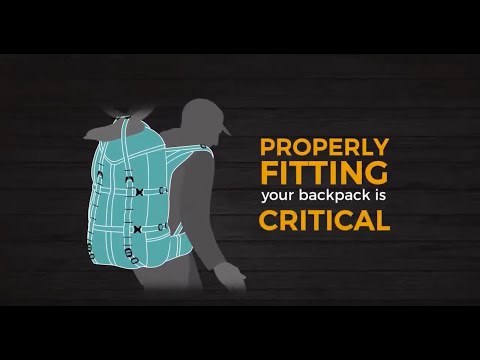
Helmuth noted that part of her positive experience was thanks to the Mystery Ranch video that shows how to wear their packs. “It was different than how I had been taught to wear other internal frame backpacks, and I was glad they had this info,” she says. The Mystery Ranch Bridger received the highest marks for fit across the board of anything we tested.
But it wasn’t just the fit that impressed the testers: They also liked the Mystery Ranch Bridger’s unique take on organization. Rather than relying on an external mesh pocket to store odds and ends, there is a more robust back compartment that zips all the way down, revealing internal mesh pockets that will negate the need for separate stuff sacks for parts of your kit, like toiletries or cooking gear. Similarly, the main compartment of the backpacking backpack could be entered through the top, bottom zip, or by unzipping the front panel in a U shape. Inside were two more side mesh pockets for organization. Even more appealing to the tidy backpackers will be the Velcro straps that tie up the loose ends of webbing after your pack is fully adjusted.
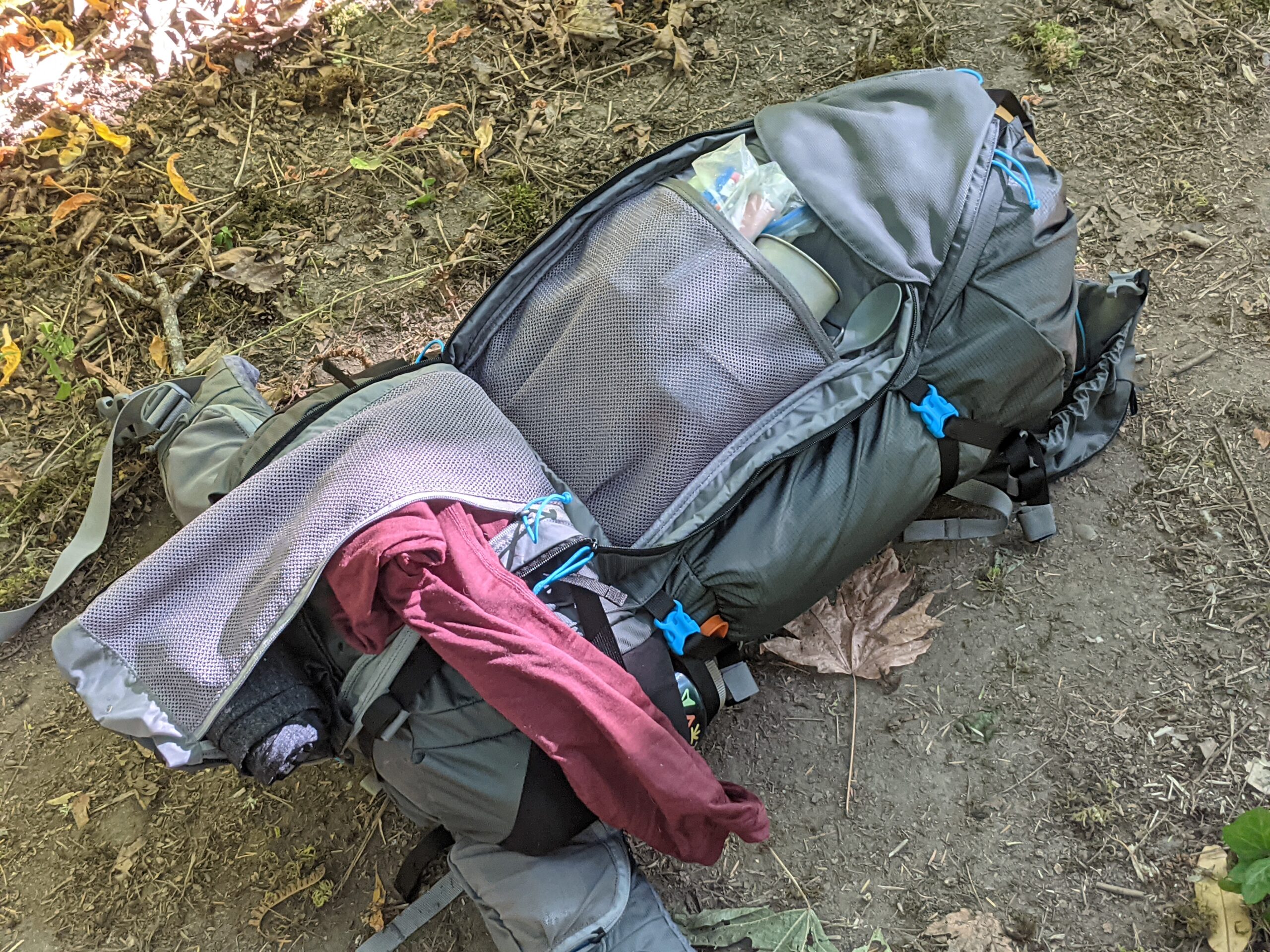
There were a few dings. Boyle struggled to fit his sleeping bag into the bottom compartment, and the testers that stored their Nalgenes in the side pockets noted that they weren’t deep enough to hold them securely. Helmuth also reported that both of the trekking pole attachments on her pack broke during testing.
Read the full Mystery Ranch Bridger 65 review to learn more.
Mystery Ranch Radix 47
Tested in the Goat Rocks Wilderness by Diana Helmuth, Laura “Chop Chop” Lancaster, Patrice “Steady” La Vigne, and Jac “Top Shelf” Mitchell
Report Card
- Fit: 3.75
- Comfort: 3.25
- Load Bearing: 4.5
- Packability: 4.25
- Accessibility: 4
- Value: 4.75
Key Features
- Price: $250
- Capacity: 45 liters
- Weight: 3 pounds, 9.7 ounces
- Men’s Torso Fit: 15 to 24 inches
- Women’s Torso Fit: 13 to 22 inches
- Pockets: Top lid pocket, two side stretch pockets, back pocket (not mesh), two hip belt zip pockets,
- Adjustment Points: Attached hip belt, shoulder straps, load lifters, adjustable back panel, two sternum straps
- Comfortable up to 30 pounds (as reported by the testers)
- Warranty: Limited lifetime
Pros
- Affordably priced
- Hews closely to the tried and true Mystery Ranch designs
Cons
- Not as cushioned as our testers wanted for such a rigid-frame backpack
- Heavy for something styling itself lightweight
More than one eyebrow was raised when the Mystery Ranch Radix, a 47-liter, 3.6-pound backpack, styled itself “lightweight.” But this is Mystery Ranch, where a 5- or even 6-pound backpacking backpack is a Tuesday (for context, there are ultralight backpackers whose entire kit weighs less than that). For Mystery Ranch, 3.5 pounds is pretty light, and given Mystery Ranch-founder Dana Gleason’s heralded reputation among backpackers, we wanted to see what it was about. Helmuth was especially curious given that her go-to backpack at home is a Dana Designs ArcFlex Terraplane, also created by Gleason.
Results were split. Testers that preferred a more traditional-style backpack — a robust frame, plenty of pockets and adjustment points, weight be damned — gravitated toward it, while the testers that preferred ultralight gear were less enthused. The biggest issue was the fit of the frame. The hip belt and back panel were some of the stiffest in our test: perfect if you want to control the position of your backpack and transfer the majority of the weight to your hips. But it does constrict your movement to an extent.
In my case, that meant more pressure on my hips than I prefer while backpacking along rocky terrain like the Goat Rocks. For Top Shelf, the dealbreaker was the long, rigid frame. She noted that despite being in the middle of the range for the torso length that the pack felt tall on her body and the top of the frame would hit her in the back of the head.
The load lifters are positioned low on the pack. Most backpackers using rigid-frame backpacks will crank down on the load lifters further than they are designed to do, because it will transfer even more weight to your hips. But this combined with a tall frame could cause the top of the pack to move uncomfortably close to your head.
Steady was unequivocal in her feelings about the Mystery Ranch Radix: “I love this pack,” she said. “I would use this pack regularly for sure. The organization and access worked for me, and, of course, I loved carrying the load on my hips.” She was especially keen on the cushioned hip belt and shoulder straps. Her only real complaint about the Radix’s fit was that her back ended up a little sweatier in this backpack than it did in the others. Helmuth, however, noted that the Radix “doesn’t hug me the way my Dana Designs or the Mystery Ranch Bridger does,” although she felt it was “still a great pack.” She reported some soreness in her lower back and chafing under her right arm while carrying a load just shy of 34 pounds.
This pack had fairly standard organizational features for a backpacking backpack, hip belt pockets, side pockets, pocket on a fixed brain. It did lack some stretch in the back pocket, and there were no shoulder strap pockets. It also sported a single zipper running down the length of the backpack, which is a fairly iconic feature for Mystery Ranch. Generally, this testing group takes a dim view of zippers on backpacking backpacks, as they are prone to clogging with dirt and failing. It was nice to see this flagship feature carried over to Mystery Ranch’s entree to lightweight backpacking, but we look forward to seeing what that team comes up with in the future.
REI Flash Air 50
Tested in the Goat Rocks Wilderness by Adam Tycaster, Ashley Thess, Jac “Top Shelf” Mitchell, and Sven “Magic” Anderson
Report Card
- Fit: 2.5
- Comfort: 2.5
- Load Bearing: 2.75
- Packability: 3
- Accessibility: 3.5
- Value: 2.25
Key Features
- Price: $300
- Capacity: 50 liters
- Weight: 1 pound, 15.3 ounces
- Men’s Torso Fit: 18 to 20 inches
- Women’s Torso Fit: 16 to 18 inches
- Pockets: Two side stretch pockets, back pocket (not mesh), two hip belt zip pockets, one shoulder strap pocket
- Adjustment Points: Attached hip belt, shoulder straps, load lifters, sternum strap
- Comfortable up to 25 pounds (as reported by the testers)
- Warranty: One year
Pros
- Under 2 pounds
- Great water bottle pockets
Cons
- Stiff, inflexible frame
- Doesn’t carry heavy loads well
Testers were surprised at the end of the test when I revealed both the weight and the price point of the REI Flash Air 50. At just under 2 pounds, it was right in line with the likes of the Hyperlite Southwest and Gossamer Gear Gorilla for weight, easily beating out the Osprey Exos, Aarn Mountain Magic Pro, and ULA Circuit. But it was more expensive than testers, accustomed to REI as a best-in-class value brand, were expecting. And ultimately, given the quality of other options on this list, they didn’t think that the weight savings were justified by the pack’s design at this price point.
Unlike other packs, testers reported a myriad of small complaints with this pack with no clear pattern. Magic reported that it didn’t move with his body like other backpacks at this weight typically do, while Top Shelf and Thess said that the frame felt stiff and inflexible. Thess even commented that she struggled with portions of the frame digging into her torso, while there was a general consensus that the pack didn’t carry well even with sub-30-pound loads. Top Shelf also noted that the laminate being used tended to be a bit sticky in humid weather.
Two bright spots with the REI Flash air was the inclusion of separate water bottle compartments that was a boon for individuals that don’t use hydration bladders. Testers also noted that the hip belt on the REI Flash Air was especially comfortable, with one tester noting that if you could swap these two features onto the Osprey Exos, you’d have the perfect backpack. Magic also said that the easy-to-access water bottle pockets were a game change for his Parkinson’s.
I was a bit surprised at how little the testers responded to the REI Flash Air 50. It has many popular features: roll-top lid, deep pockets at the side and back, a Y-strap that can be used to secure additional gear on top of the pack, and a shoulder strap pocket. But when the group sat down to go through the packs, there was little to say about the REI Air Flash 50 compared to other packs that elicited strong feelings in either direction. In the end, I wonder if it was this unexpected marriage of features: a backpack that presented and weighed-in as ultralight but then tried to carry like a traditional backpack that just didn’t sit right, leaving the testers feeling that this backpack simply wasn’t for them even if there wasn’t anything all that wrong with it.
Outdoor Vitals CS40 Ultra
Tested on the Oregon Coast Trail by Laura “Chop Chop” Lancaster and Patrice “Steady” La Vigne
Report Card
- Fit: 4
- Comfort: 4
- Load bearing: 4
- Packability: 3.5
- Accessibility: 3.5
- Value: 4
Key Features
- Price: $370
- Capacity: 53 liters
- Weight: 1 pound, 11 ounces
- Unisex Torso Fit: 18 to 22 inches
- Pockets: Two hip belt pockets, two side pockets, back mesh pocket
- Adjustment Points: hip belt, shoulder straps, load lifters, sternum strap
- Comfortable up to 30 pounds (as reported by the testers)
- Warranty: Lifetime
Pros
- Great back panel padding and ventilation
- Roomy back mesh pocket
Cons
- Expensive
- Profile is somewhat slack
- Aggressive J straps were less comfortable for our testers
There are a lot of positives about the Outdoor Vitals CS40 Ultra. It’s lightweight, thanks in part to its 200D Ultra exterior. It has a great back mesh pocket that not only holds all of your small items, but also allows you to see where they are — decidedly not the case for all the mesh pockets we looked at. It’s got plenty of capacity and it carries loads reasonably well, producing only a minor crick in one tester’s shoulder after 10 miles and 1,200 feet of elevation gain through muddy terrain.
But where this pack really stood apart from the crowd was in its ability to manage sweat along the shoulder straps and back panel. Traditionally, the sweatiest long-distance hikers have gravitated toward Osprey’s packs, including the 40-ounce Exos, because of its best-in-class back panel ventilation. And this isn’t a small point: For some backpackers, back panel chafe can be a debilitating, hike-ending issue. That makes the vast majority of ultralight backpacks a virtual nonstarter.
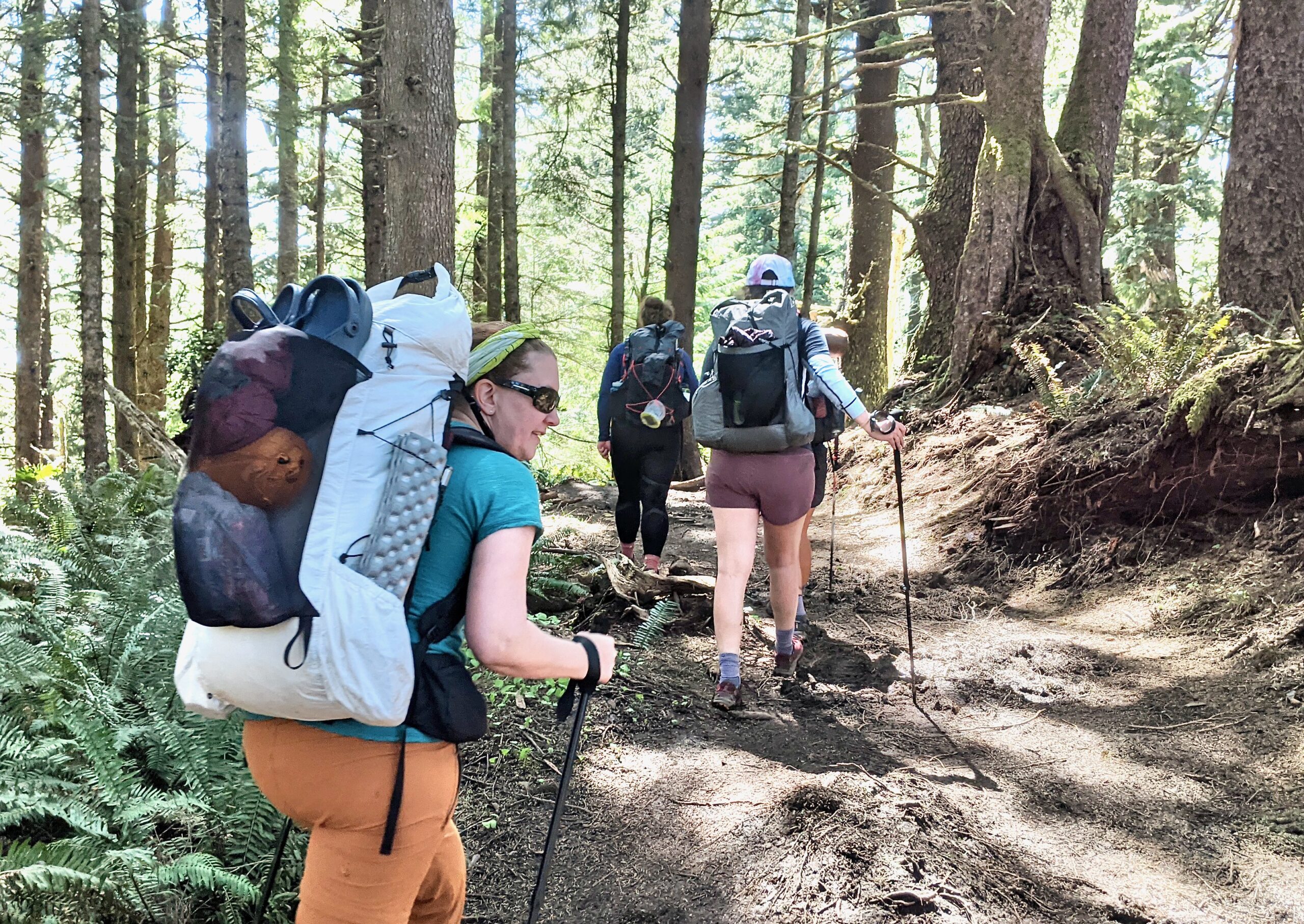
Steady (who says she sweats “just by looking at the sun”) took this pack out on day four, when temperatures climbed into the upper 70s right as we hit a destroyed section of trail that necessitated some bushwhacking. Not only did she find the back panel to be the most comfortable of everything she tried, but she also didn’t feel any sweat against her back. That’s because, in addition to being ventilated, the padding is also raised off the middle portion of the Outdoor Vitals CS40 Ultra, and overlaid with a mesh layer that allows some airflow to move beneath it. If you’re used to using an Osprey pack, you might be disappointed with the level of airflow provided, but if you are looking for an upgrade from a typical ultralight backpack, this is a massive improvement.
The biggest ding against the Outdoor Vitals CS40 Ultra is that it looks a little sloppy. The mesh of the back pocket is a bit loose, the roll-top bunched up, the side pockets drooped. While this is ultimately more an aesthetic concern than a practical one, at this price point we’d expect a backpack to look a lot sharper. For this testing group — all women — the aggressive J-straps also proved noticeably less comfortable than other models we tested. If your chest has any bulk to it, check out the Duston Kakwa 40 or the ULA Circuit.
Deuter Aircontact Core 65 +10
Tested individually by Rebecca Ross, Jason Boyle, and Diana Helmuth
Report Card
- Fit: 3.5
- Comfort: 3
- Load Bearing: 4.5
- Packability: 4.5
- Accessibility: 3.6
- Value: 3.1
Key Features
- Price: $250
- Capacity: 60 liters (can expand to 70 liters)
- Weight: 5 pounds, 1.5 ounces
- Unisex Torso Fit: 16.5 to 24.5 inches
- Women’s Torso Fit: 14 to 22 inches
- Pockets: Two top lid pockets, two side stretch pockets, back mesh pocket, two hip belt zip pockets
- Adjustment Points: Attached hip belt, shoulder straps, load lifters, adjustable back panel, sternum strap
- Comfortable up to 45 pounds (as reported by the testers)
- Warranty: Lifetime
Pros
- Has every adjustment point and pocket you expect from a backpacking backpack
- A great match for more typically masculine builds
Cons
- Can be difficult for women to balance
- Some durability issues with the mesh
Boyle was effusive in his praise of the Deuter Aircontact Core. He noted several times on his testing sheet that the pack fit amazingly well and that it was the most comfortable pack in the test series. Notably, it supported the typically heavy loads he carries into the Appalachians, and was simple to fit to his frame using the various adjustment points, including the Variglide back panel adjustment. Boyle also liked that he could move the compression straps around, which made it easier to change up his load when he was out guiding clients through Shenandoah National Park.
He noted disappointment that the Deuter Aircontact Core did not include an integrated rain cover (which comes with other Deuter backpacks), and that the mesh sections were slightly fragile if rubbed against an abrasive surface, like a rock wall. But these, for him, were small points. “No matter how much weight I was carrying, I never really felt it,” he says. “The pack fit so well, I could almost forget it was there.”
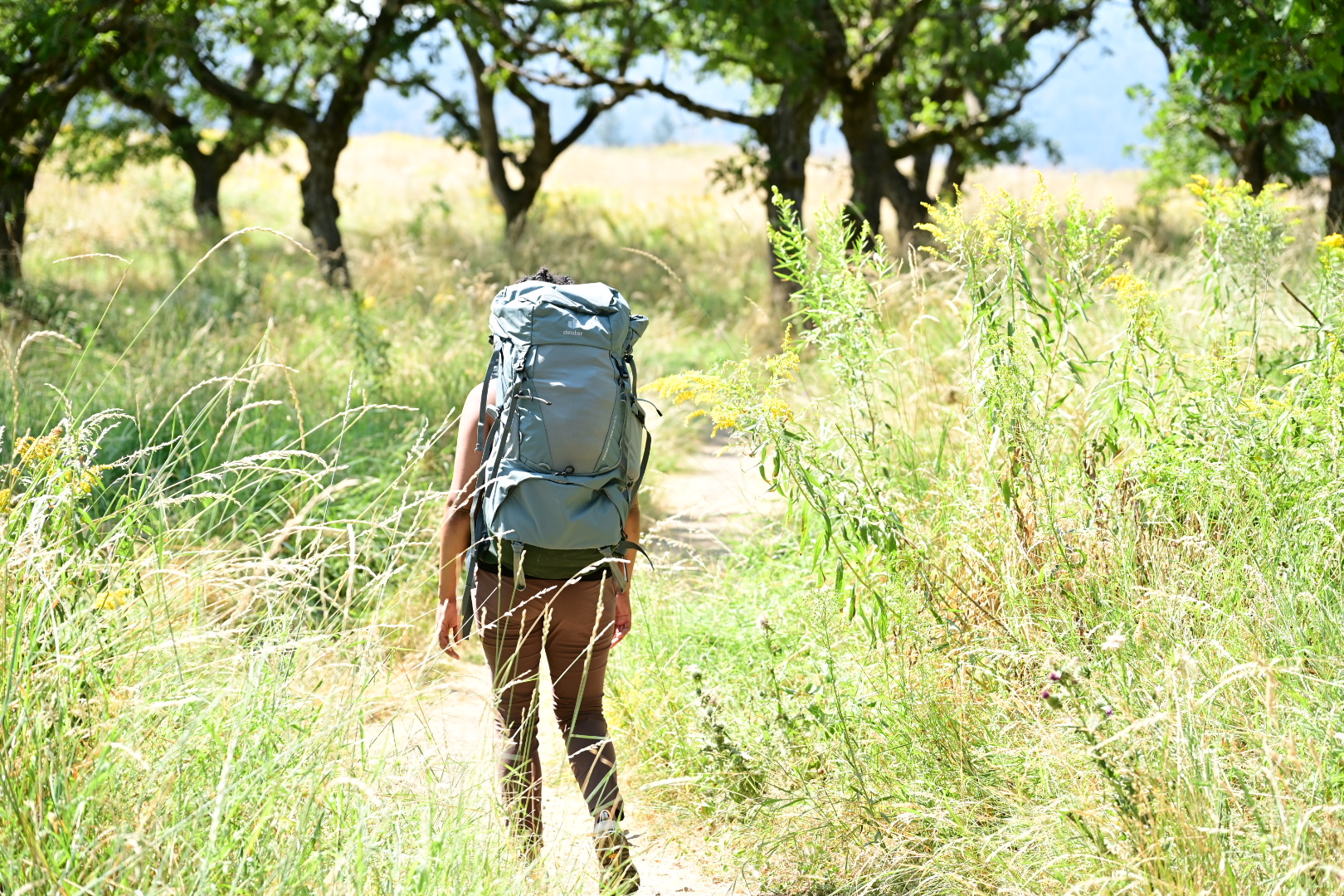
This turned out to be at odds with both Helmuth’s and Ross’s experience. While Helmuth was out on an overnight to the Carbon River in Mount Rainier National Park, she found that when the load lifters were loose, the weight of the pack settled on her hips, but when she cranked them down to help move the weight to her shoulders, the top of the pack would hit the top of her head. Ross reported that her smaller physical stature made this one-size-fits-all backpack even more of a no-go. “The internal frame of the backpack hit the back of my head at such an uncomfortable spot that I turned my overnight backpacking trip into a day hike,” she says. Ross also found that the weight in the pack kept unbalancing while she was out testing, so that the pack repeatedly tipped to one side.
Overall, the ergonomics of this backpack, including its hip belt, seemed to pair significantly better with men’s more typically streamlined builds. (For this test, Boyle was sent the SL pack, which is considered the women’s fit.)
All three testers noted that the organization of this pack epitomized what they look for in the features of a backpack. A healthy sized sleeping bag compartment. A stretchy mesh back pocket. Two side pockets for water bottles and two hip belt pockets for snacks. A top lid that fits all their important items with room to spare. The top of the main compartment can also be pulled up to expand the pack from 60 liters to 70 liters. Anyone with a typically masculine build that prefers traditional-style backpacking backpacks would be well served by the Deuter Aircontact Core.
Read the full Deuter Aircontact Core review to learn more.
Gregory Baltoro & Deva
Report Card
- Fit: 4
- Comfort: 3.2
- Load bearing: 4
- Packability: 4.1
- Accessibility: 4.3
- Value: 3
Key Features
- Price: $300
- Capacity: 65 liters (Baltoro); 60 liters (Deva)
- Weight: 4 pounds, 14 ounces (Baltoro)
- Baltoro Torso Fit: 16 to 21 inches
- Deva Torso Fit: 14 to 20 inches
- Pockets: Three top lid pockets, one side stretch pocket, one water bottle holder, back mesh pocket, two back zip pockets, two hip belt zip pockets
- Adjustment Points: Attached hip belt, shoulder straps, load lifters, adjustable back panel, sternum strap
- Comfortable up to 50 pounds (as reported by the testers)
- Warranty: Limited lifetime
Pros
- Thoughtful design elements, including a dedicated water bottle pouch
- Contoured hip belt works well with typically feminine bodies
Cons
- Velcro back panel is easy to inadvertently create a lopsided profile
- Pre-curved hip belt was uncomfortable for our male tester
If the Deuter Aircontact Core fit my male testers great, while leaving my female testers struggling, the Gregory Baltoro and Deva were the opposite. Boyle tested the men’s version of this pack (the Baltoro), and reported that, despite being quite padded, the hip belt felt tight against his hips. Part of this was that the curved shape was somewhat misaligned with his frame; at one point, leaving his phone inside the hip belt pocket resulted in a bruise.
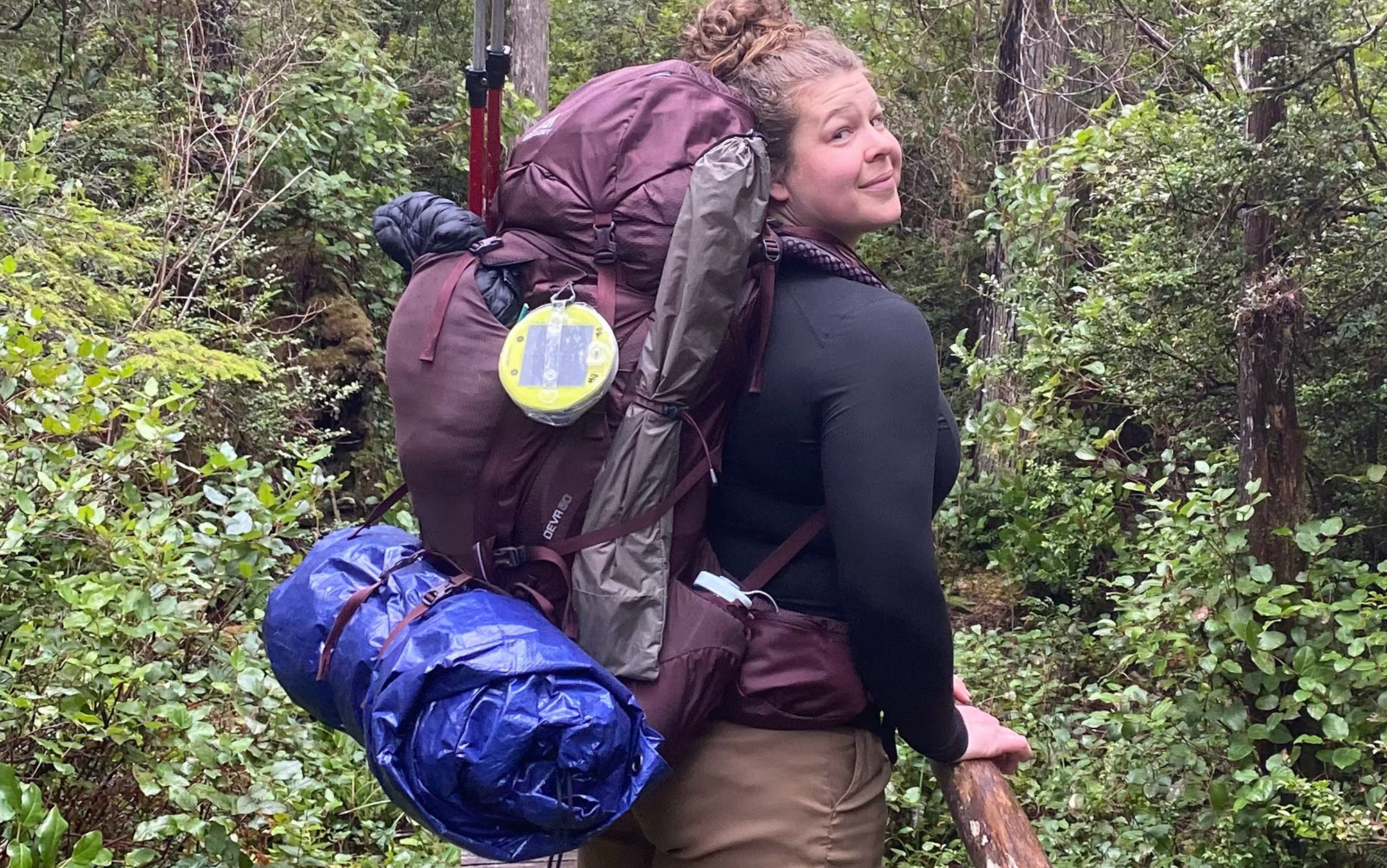
Ross’s and Helmuth’s experience with the Gregory Deva (the women’s version of the same pack) was, fortunately, a different story. Despite initially struggling with the Velcro adjustment panel (lopsided shoulder straps resulted in pain in her left trapezoid), Helmuth felt that, overall, the pack fit her frame well. Ross had a similar experience with the fit of this backpack, giving it a 10 for fit and an 8 for comfort.
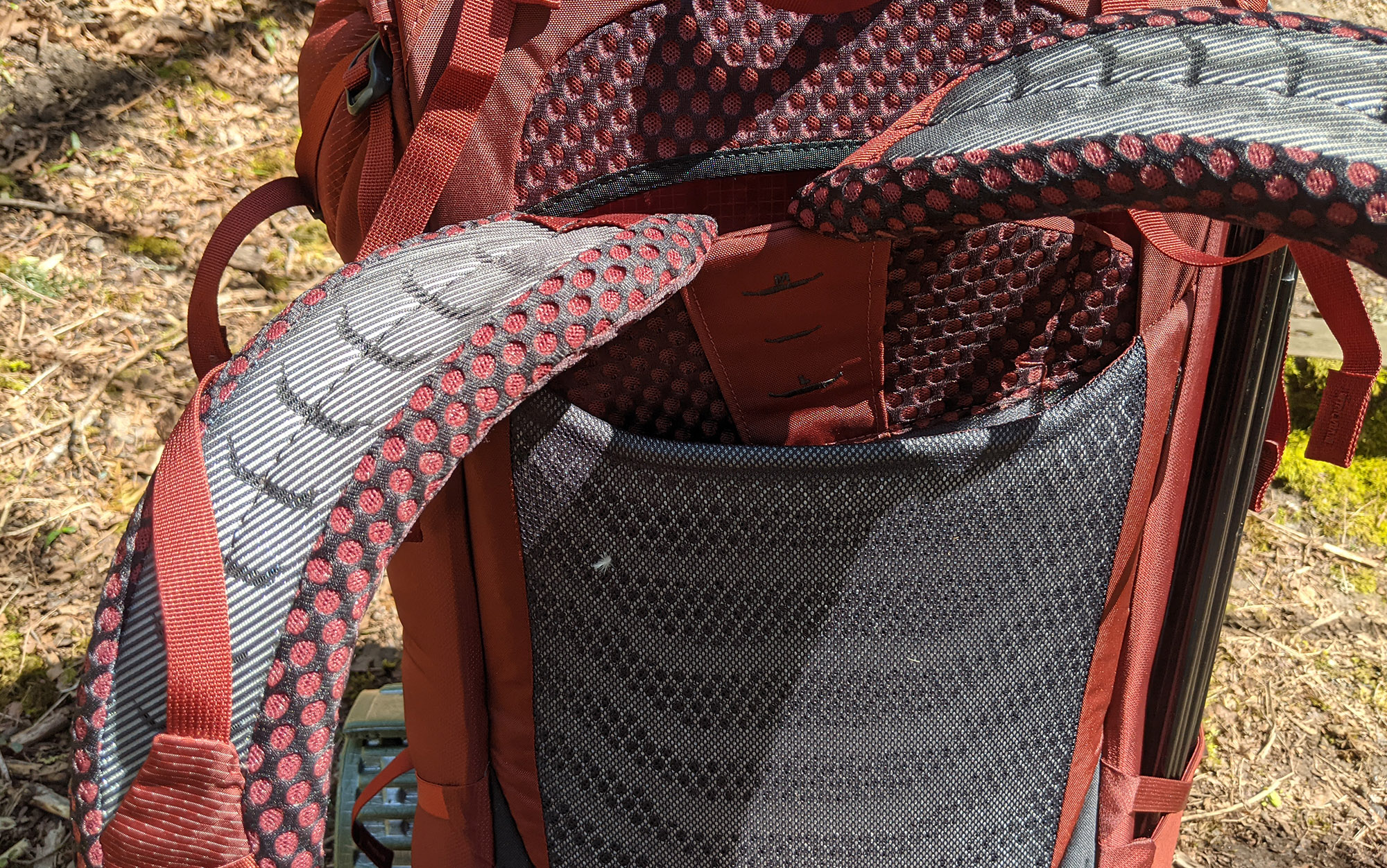
But what really won them over, winning 10 points from each, was the Gregory Deva’s approach to storage and accessibility. Ross liked the three different compartments for the brain. “It allowed me to keep my smaller items organized,” she says. Ross also appreciated being able to easily access the main compartment without unbuckling the brain, as it saved her time when searching for a specific item. Both Ross and Helmuth also commented on how easily accessible their Nalgenes were while hiking, thanks to the dedicated side water bottle holder.
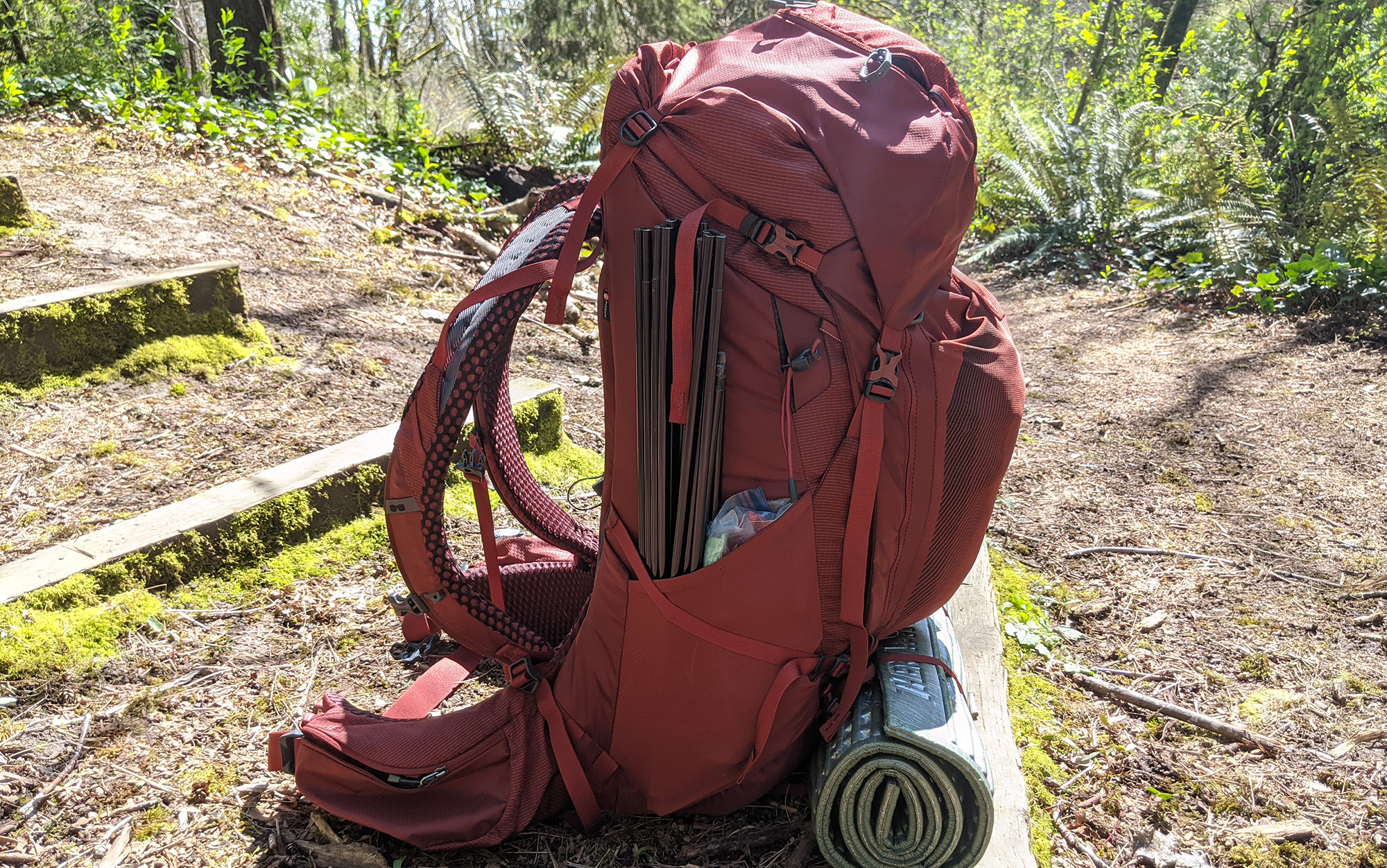
While neither Ross nor Helmuth had any particular difficulty fitting their shoulder season gear into the backpack, Boyle found that his larger gear kit was difficult to fit into the available pockets. “It’s the smallest packing, 65-liter pack I have used,” he says.
Read the full Gregory Baltoro and Deva review to learn more.
Zpacks Arc Haul Ultra 40
Tested on the Oregon Coast Trail by Jac “Top Shelf” Mitchell and Ashley Thess
Report Card
- Fit: 3
- Comfort: 3
- Load bearing: 4
- Packability: 3
- Accessibility: 2
- Value: 2
Key Features
- Price: $400
- Capacity: 60 liters
- Weight: 1 pound, 2.8 ounces
- Available Torso Sizes: 16 to 26 inches
- Pockets: Two side pockets, back mesh pocket
- Adjustment Points: Hip belt, shoulder straps, load lifters, sternum strap
- Warranty: Two years
Pros
- Very lightweight
- Great load bearing
- Fits well
Cons
- Expensive
- Fewest pockets in our test
The Zpacks Arc Haul Ultra is exactly what it promises: It strips away everything you don’t absolutely need and uses the absolute lightest materials for everything else. And it does that while staying true to the needs of thru-hikers. It does not skimp on load bearing, boasting both load lifter straps and carbon fiber stays that provide significant structure to this pack.
It does, however, skimp on features — too much, it turned out, for our testers. We should also note that it’s expensive, along with the Black Diamond Beta Light, it’s one of the most expensive we’ve ever tested. But it’s also one of the lightest packs we’ve ever tested.
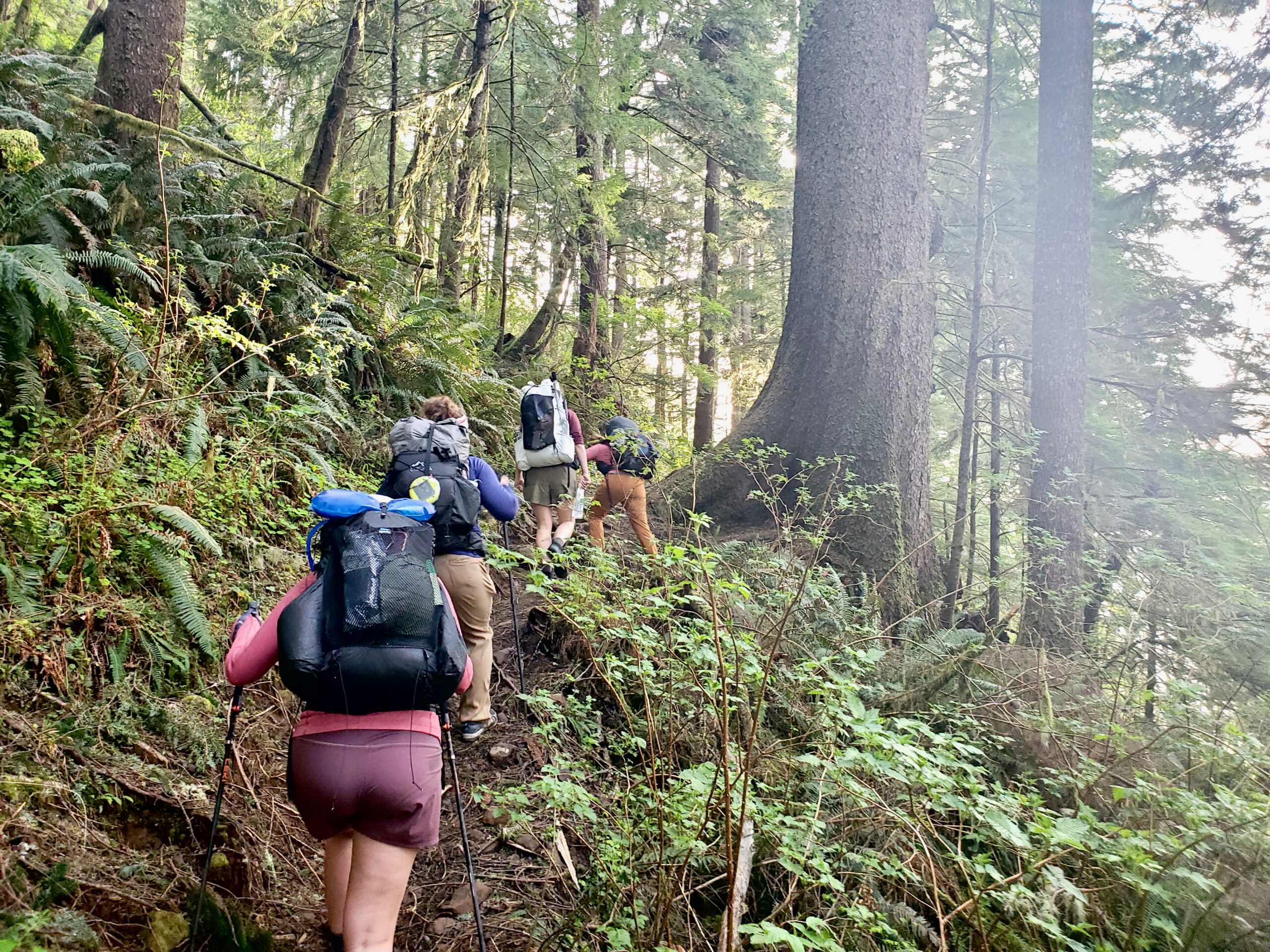
Both of the testers for this pack were impressed with how well the Zpacks Ultra Arc Haul handled the loads typical of ultralight backpackers, thanks in part to the stiff back panel that helped to distribute weight. They even pushed the weight to 26 pounds by strapping a water bladder to the pack during a dry section of the hike. The tester who hauled that load noted that the Zpacks Ultra Arc Haul handled the additional pounds well given how unideal the setup was. And the adjustments were comfortable and conformed to the testers’ bodies the way they wanted them to. This is, after all, an ultralight backpack’s most important job, and the Zpacks Ultra Arc Haul gets it done.
So what didn’t they like? Both testers struggled with accessibility with the Zpacks Ultra Arc Haul, even compared to similar models like the Durston Kakwa 40 and the Palante Desert. There were no pockets on the hip belts, or on the shoulder straps (Zpacks does sell these as fairly pricey additional add-ons), so to get anything out of their packs they had to stop to take it off. They also had durability concerns with some of the non-Ultra parts of the pack — particularly the mesh on the back pocket.
Other Backpacking Backpacks We’ve Tested
I tested the Gossamer Gear Gorilla on OL’s inaugural backpacker gear test, and came back less enthused than I had hoped with the pack’s overall performance given its reputation. It adhered to a minimal design and frame — no load lifters in sight — but was less compact than other backpacking backpacks in that style. The net effect was that even with a lighter load than typical for me, I felt the pack pulling down and out from my shoulders more than I would have liked. Since that test, Gossamer Gear has added load lifters to the Gorilla. While I expect this will help to alleviate some of the issue, I have yet to test this new version out.
My smallest tester, Rebecca Ross, was impressed by how well the Kelty Coyote fit her frame, making that backpacking backpack an especially great budget pick for individuals with short torsos — which is a fairly uncommon find. Unfortunately, that backpacking backpack has since been discontinued.
Helmuth, Boyle, Ross, and I all tried out the Big Agnes Parkview and Garnett with high expectations, given Big Agnes’s reputation among backpackers for their tents. While there were aspects of this pack that they thought were best-in-class, including its approach to the back panel adjustment, generous side mesh pockets, and the trash can, its overall stiffness (even over multiple trips) made it one of the least comfortable packs we’ve looked at.
Things to Consider When Choosing a Backpacking Backpack

Alex Robinson
Frame Style
The vast majority of contemporary backpacking backpacks have rigid internal frames. This, when it’s working correctly, transfers much of the weight of your pack from your shoulders to your hips, which are almost always stronger than your shoulders. And for some people, this style of backpack works great. Unfortunately, you don’t have to spend much time on trail to recognize that this style of backpack doesn’t work for plenty of others.
The problem with rigid internal frames is that the weight and pressure of a heavy load is always going somewhere, and if you can’t get the right fit for your body type, pain points crop up. Telltale signs are bruised hips, bruised collarbones, packs that are hanging too low or too high — all evidence that the user is trying to shift the weight around on their body to get a more comfortable fit. If that sounds familiar, you may want to try a different backpacking backpack style.
Another style of backpacking backpack doesn’t try to balance the weight on your hips, but instead wrap around your body so that the weight is balanced everywhere equally. These backpacks, which I’ve termed here “wrap-around” frame backpacks typically have unusual adjustment points that may take some time to get used to.
A third style of backpack has a removable frame. With these backpacks, you can alternate between a more rigid structure that positions the weight on your hips and a softer structure that hugs the body and places more weight on your shoulders. This latter style is more popular with lightweight and ultralight backpackers that have smaller loads.
Capacity
The temptation is to always get a backpacking backpack that is slightly bigger than you think you’ll need, just in case. But I would caution you to go in the opposite direction, err on the side of something that’s a bit too small. Backpacking at its best is an exercise in minimalism. The fewer extravagances — like backpacking chairs or solar showers or a change of outfit for every day — you carry, the less weight you’ll carry. And when you carry less weight, you can go farther and feel stronger.
For most backpackers, who are heading out for an overnight or a couple of nights at a time, a 45-liter backpack will offer plenty of capacity for the essentials. If you have a week or more trip in your sights, then a backpack in the range of 55 or 60 liters would be appropriate. Backpacks that are 70 liters or larger are best reserved for either guides or individuals carrying additional gear for climbing or hunting objectives.
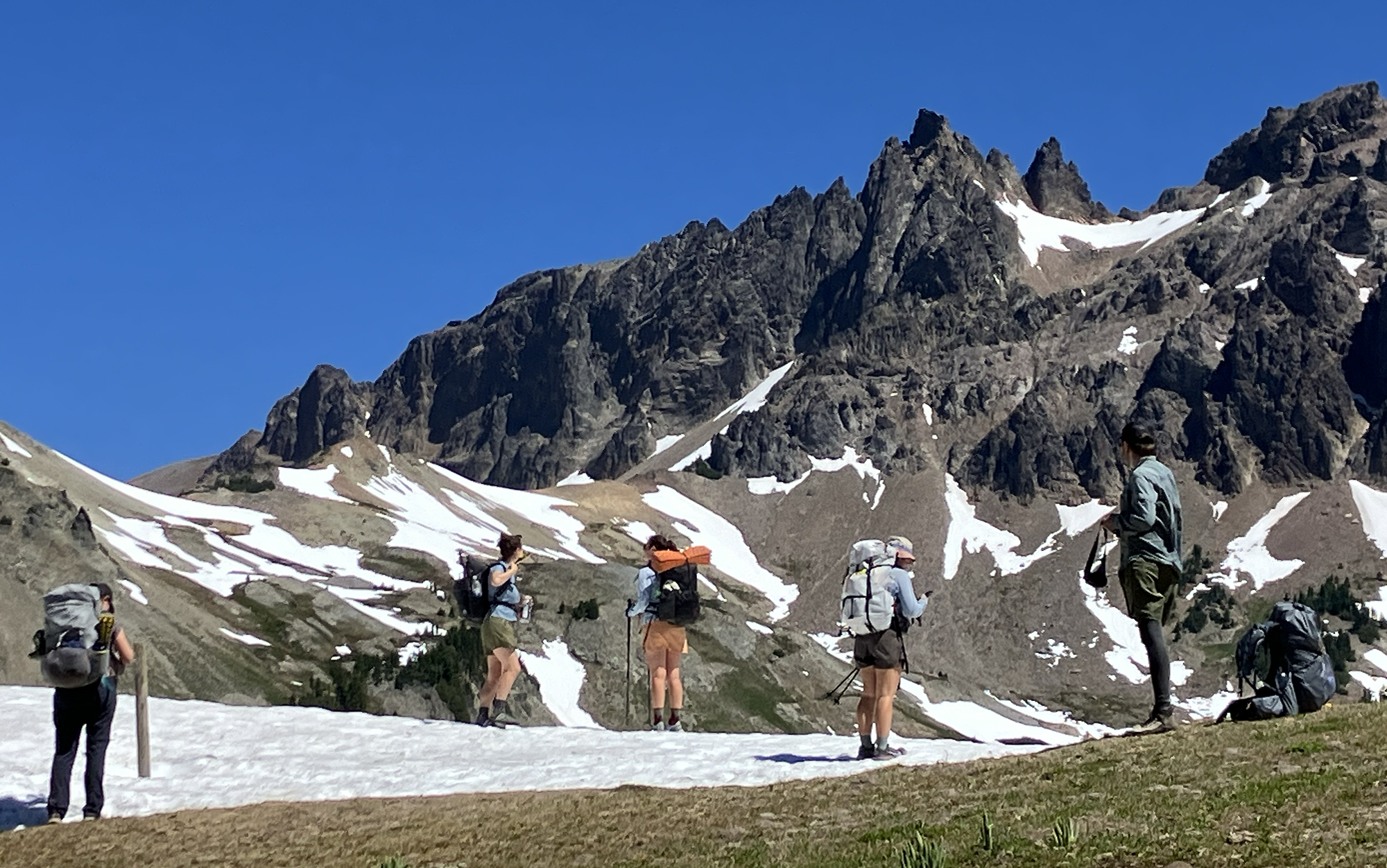
Diana Helmuth
Weight
For decades, backpacking backpacks were dominated by unnecessarily heavy, overly padded options that were too large and complicated. In recent years, with the mainstreaming of ultralight-style backpacking, there has been a subtle shift away from more fully featured options toward a more streamlined minimal style. The challenge for most backpackers is finding the sweet spot for their particular biomechanics and packing style. Unless you have a dialed-in ultralight kit, I would encourage most backpackers to look for a pack in the range of two to three pounds, which is the sweet spot for gear that isn’t adding unnecessary bulk but can still handle loads of up to 30 pounds or more.
Pockets
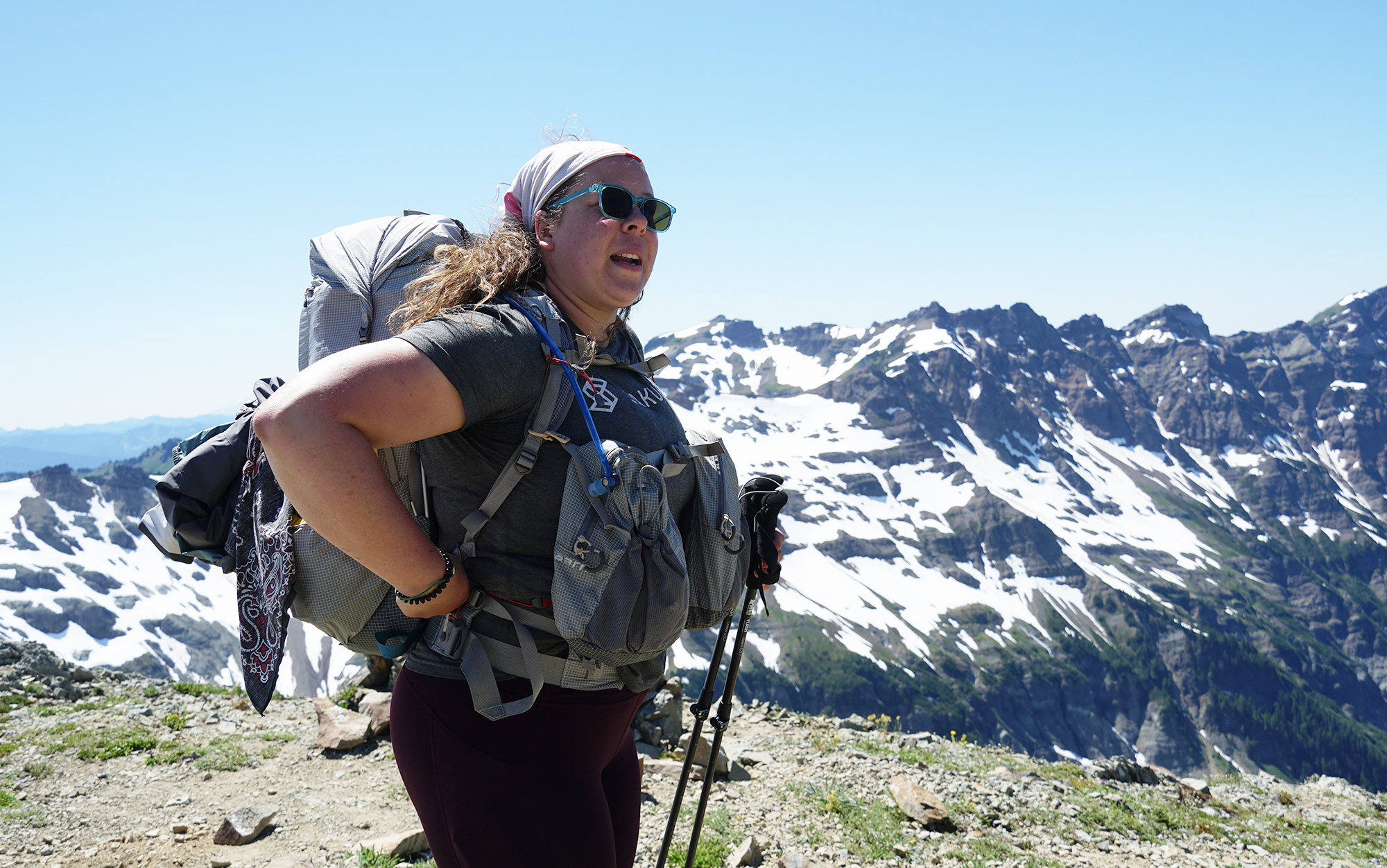
Alex Robinson
For many, the hardest adjustment with switching from a more traditional backpacking backpack to a lightweight or ultralight model is the difference in pocket design. The most noticeable difference is the use or exclusion of a lid on the top of a backpack, often referred to as the brain. Traditional-style backpacks almost always have this feature, and many find them convenient for storing and organizing small odds and ends — Helmuth in particular is miffed if there isn’t also a zipped pocket on the underside of the lid explicitly for storing her bathroom supplies. Lightweight and ultralight backpacks almost never have this lid. For those manufacturers and their fan base, the added weight of that pocket doesn’t justify its holding capacity, and there is a tendency for users to inadvertently overload with electronic devices, sunscreens, headlamps, and other small, dense items that can result in a top-heavy backpack.
Another difference is in the sleeping bag compartment, which are not included on lightweight or ultralight backpacks but are often considered an essential feature on traditional backpacking backpacks. (It’s this gear tester’s opinion that if digging out your sleeping bag and pad from your backpack is arduous then there is probably too much stuff in your backpack that you aren’t using.)
Conversely, lightweight and ultralight backpacks often include shoulder straps pockets, so that users can more easily access small odds and ends while hiking. They also tend toward generously sized and stretchy back pockets. However, even with these additions, the overall effect is fewer pockets and organizational options.
Price
Given that boutique goods are almost always more expensive than mass-produced goods, it’s no wonder that so many people have the misconception that lightweight and ultralight backpacking gear made by small companies (sometimes only consisting of a handful of people) would be more expensive. But when it comes to lightweight and ultralight gear, the inverse is often true. For instance, Granite Gear, which has only a couple dozen employees, had one of the lowest priced packs on this list.
FAQs
Yes, a 50-liter pack is enough for backpacking, although for longer treks you may need to be judicious about what you do and do not bring.
The size backpack that you need for three days of backpacking will depend on the size of your gear, but most people can get away with a 50-liter or less. The biggest determining factor for most beginning backpackers is the size of their sleeping bag (which should be kept inside your pack, to protect it from the elements). If yours is a bulky synthetic bag, aim for a slightly larger backpack. If it’s a svelte high-fill power down model, you can go smaller.
You typically cannot use a 60-liter pack as a carry-on. The exception to this is frameless or minimalist backpacking backpacks, as the longer frames on these can sometimes be compressed down far enough to squeak by. If you are looking for a backpacking backpack that can double as a carry-on, it’s better to go with 45 liters or less, and cross your fingers that the airline attendants turn a blind eye when you stroll down the air bridge.
Generally, you want to aim for a total weight, including food, water, gear, everything, of no more than 20 percent of your total body weight. However, the reality is that some packs carry heavier loads better than others. If you prefer to carry a heavy load when backpacking, refer to our testers’ take on the maximum carrying capacity for each backpack in the above story.
Final Thoughts
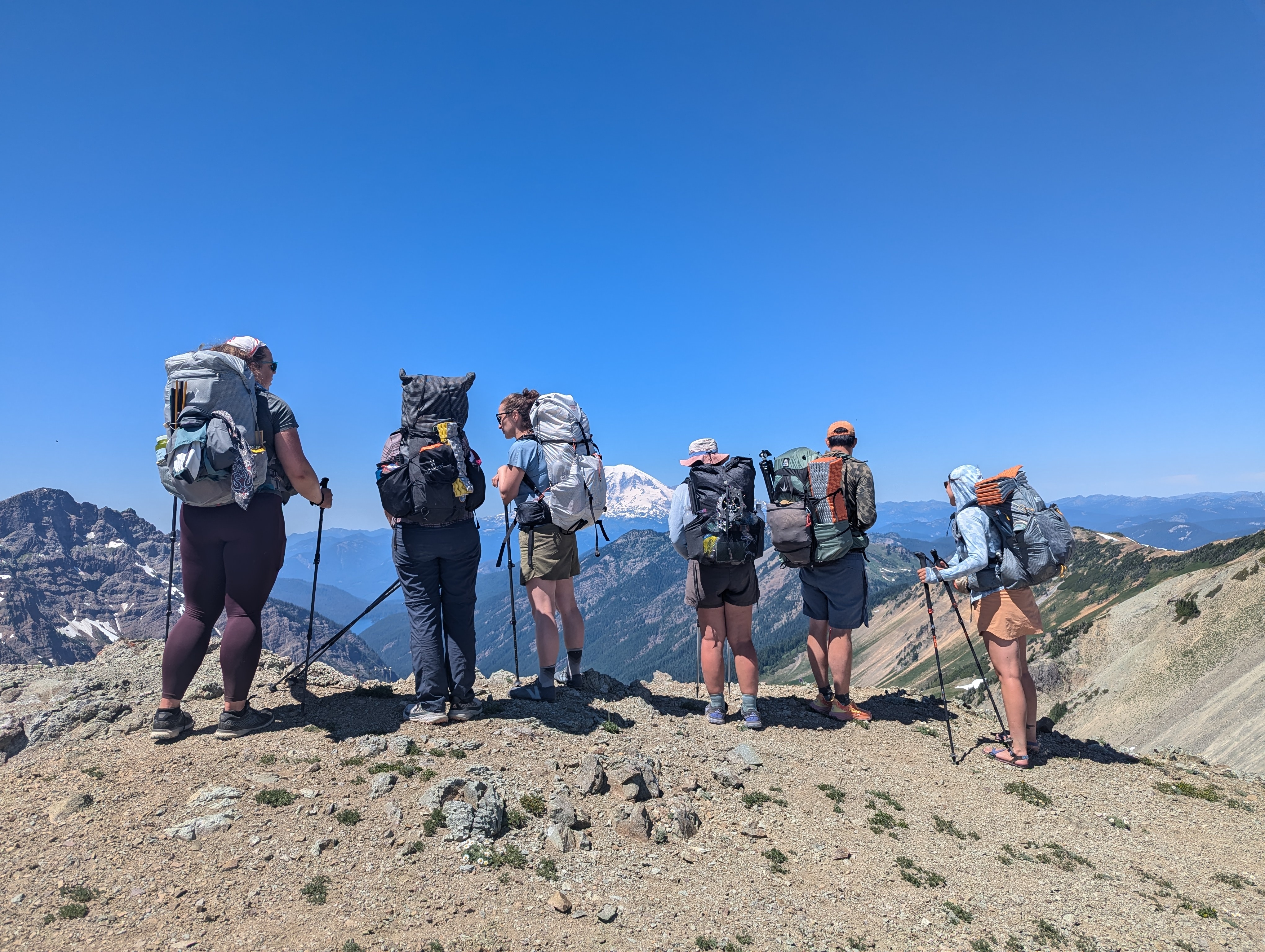
Adam Tycaster
Choosing a comfortable, well-fitting backpacking backpack is foundational to your experience in the backcountry. Our experienced testers reported back on how some of the most popular models on the market interacted with the ergonomics of their body types. In most cases, these varied significantly: One tester’s perfect pack would be a nightmare for someone else. When choosing a backpack, remember that your experience and comfort — not the wisdom of the crowd — is paramount. Here is our take on the best backpacking backpacks for different body types.
The post The Best Backpacking Backpacks, Tested and Reviewed appeared first on Outdoor Life.
Source: https://www.outdoorlife.com/gear/best-backpacking-backpacks/

